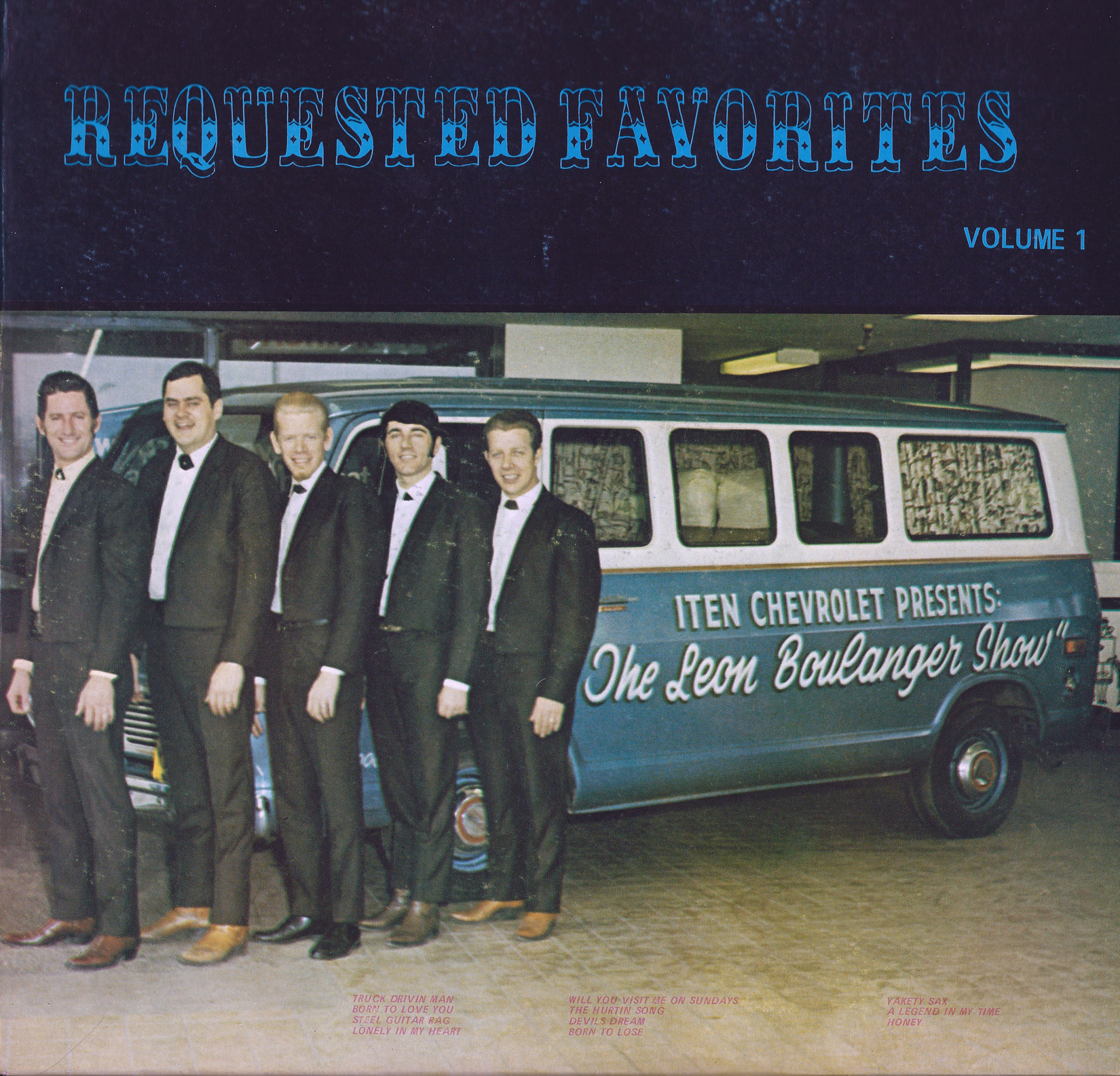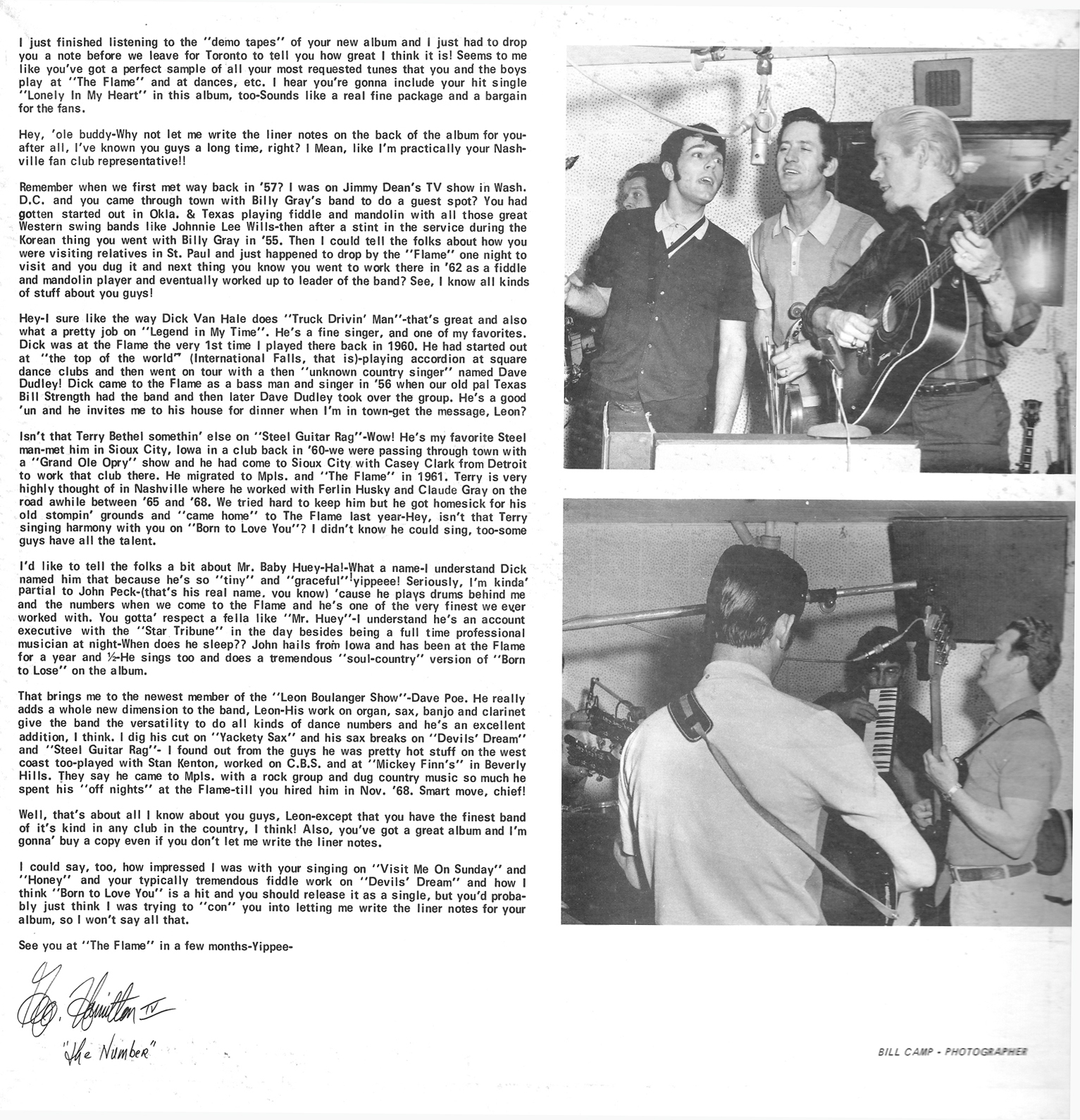Flame Cafe
This page covers three different music venues located at 1523 Nicollet Ave. in Minneapolis.
- The Happy Hour Cafe
- Club Carnival
- The Flame Cafe
Please be sure not to confuse this venue with the other three Flames in town:
- The Flame Theater Lounge, 1605-07 Nicollet Ave.
- The Flame Room at the Radisson Hotel
- The Flame Jazz Club in St. Paul
There may be more! As with all my pages, I invite additions and corrections. Most of the information presented has come from old newspapers, which aren’t exactly known for their accuracy. Please Contact Me, preferably by email, if you have better information to share. I would also love to have photos taken inside the Flame, but not those publicity stills of the performers.
THE PERCANSKY BROTHERS
The three venues in this spot were owned and run by brothers Abe Percansky and Raye D. Perkins, two of 11 children of Morris and Edna Percansky. The Percanskys came to America from Jassy, Roumania (now Iasi, Romania) in 1913 and 1914 with eight of their children – the last three were born in America. Raye and Abe were the third and fourth oldest, respectively.
RAYE
Raye David Perkins, born October 9, 1901, was listed as Raphael Percansky in the 1920 Census, and apparently legally changed his name before 1930. Raye took time off from his duties at the club for some very interesting side projects.
Roller Skates: In 1943 he became the publicity director (and possibly co-owner) of “Skating Vanities,” a traveling roller skating show starring Gloria Nord. In 1944 he was quoted as saying, “When you see Gloria Nord on roller skates you will throw bricks at Sonja Henie.” (Des Moines Tribune, January 25, 1944)
Ice Skates: In 1952 Will Jones referred to Raye as the manager of the Flame, but by September 1953, he was somehow Sonja Henie’s manager, and working to get her permission to perform in Moscow, which, according to Wikipedia, she never did. (New York Daily News, September 2, 1953)
A Dead Whale: After some preliminary showings around New York, on May 1, 1954, Raye took a 75-ton embalmed dead whale named Mrs. Haroy to Coney Island as an attraction. Despite daily injections of formaldehyde, the whale’s smell was overwhelming, and on July 1, 1954, he received a summons from the NY Department of Health. This news went out on the wire service and appeared in papers all over the country.
At a hearing on July 20, 1954, the court ordered that the whale had to be chopped up, and the Department of Sanitation would take it to a dump on Staten Island where it would be buried under three feet of dirt. A bench warrant was issued for Raye, who didn’t show up for the hearing. (New York Daily News, July 21, 1954). By August 10, 1954, Will Jones reported that Raye had returned to Minneapolis to manage the Flame.
Raye died on June 13, 1982, and was interred at Lakewood Cemetery in Minneapolis.
ABE
Abraham Percansky was born on April 18, 1903. He often went by Perkins, but he didn’t legally change his name.
From 1921 to 1924 he was a taxicab driver. On April 19, 1924, he drove for the Tip Top Cab Co. and was involved with a murder in front of Vienna Café at 322 Nicollet. Abe and Kid Cann (identified as Harry Bloom, poolroom proprietor) got in a fight over a girl and Abe drew a gun. Kid/Harry took it away from him. Kid/Harry gave the gun back to Abe and the fight resumed. Charles Goldberg stepped in to stop it, and he got shot and killed. Abe was arrested along with Kid/Harry, but eventually Harry Bloom confessed to murder on May 2, 1924. This is confusing because Harry Bloom was Kid Cann’s brother, so who was it?
Abe was arrested in Illinois on July 26, 1924, with 119 gallons of alcohol in his car, along with Patience Barnes, the woman in question in the April shooting. He was not convicted. Note that in the 1980s when Abe’s license was not renewed for the Flame he repeated over and over that he had never been arrested. He had, just never convicted.
Abe was apparently involved with the Ramona Cafe, at 1102 Hennepin Ave. N., as early as 1926 when he received a license for a pool table. He married the former Mildred A. (Mollie) Traub on December 24, 1931, and they ran the Ramona until 1938, when the Ramona’s liquor license was transferred to the new site.
THE BUILDING
The lot was originally numbered 1521 Nicollet, and a two-story wooden dwelling was built on the property in September 1885, according to the City’s building permit card. The demolition permit was taken out on August 1, 1938.
The new building was built in 1938 by Abe Percansky and Raye D. Perkins. The first page of the permit card seems to be missing, so it is unclear when the initial building permit was taken out.
Financing of the building may have been provided by Kid Cann, the head of the Minneapolis liquor syndicate, who then spent many a happy hour at the Happy Hour. There was a great deal of newsprint spent speculating as to whether Cann somehow had an ownership of the club, which would have been illegal for a felon, or secretly ran the place. It was no secret that Cann and Abe were friends. Abe owned it continuously until it closed.
CONFIGURATION
The footprint of the building was long and thin: 50′ by 140′. The space was divided into two rooms. An article from the July 22, 1967, issue of Billboard magazine written by Bill Williams describes the infrastructure. (Some of this may only apply to the Flame era.)
The Front Room was also known as the Lounge or the bar. An elevated stage hung over a circular bar.
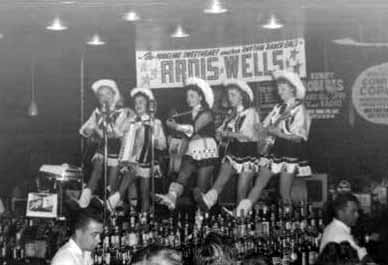
Photo courtesy Brett Williams
A hallway ran between the two rooms.
The Main Room, also known as the Back Room, (the Happy Hour called it the Cabaret and the Club Carnival called it the Fiesta Room) featured the headlining acts. This was a restaurant that seated 282 patrons, a bar, and a square stage.
HAPPY HOUR CAFE
1938
On December 17, 1938, the Minneapolis Star reported that the Happy Hour was built and furnished at a cost of $125,000. Abe Perkins said,
Because we have confidence in Minneapolis and its people, we have erected the finest building of its kind in the country here. Minneapolis is on the upgrade in business and industry, and we want to do our share to help make our native city grow.
The Happy Hour opened on December 21, 1938. Its owner was Ramona Bar & Cafe, Inc. It had the liquor license of the old Ramona Bar & Cafe. Mildred (Mollie) Percansky, Abe’s wife, was Secretary-Treasurer of the Corporation.
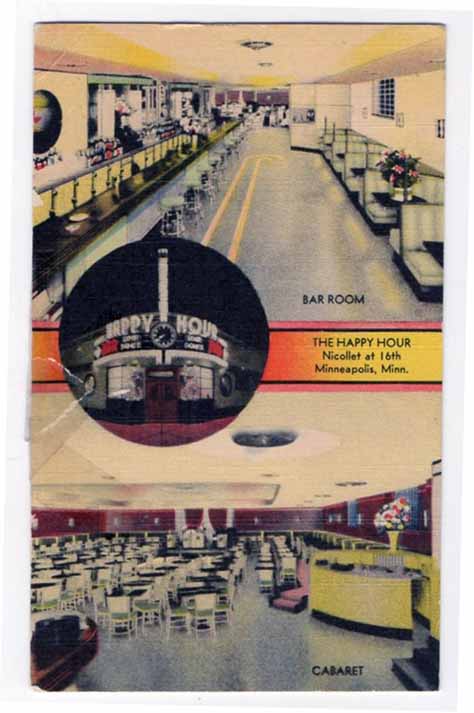
Image courtesy Mary Ann Steinberg Kolb
1940
In 1940 a “skylight” bandit waylaid an employee at 2 am and made off with about $3,000.
In May 1940, a charge of gambling aimed at Mildred (Mollie) Percansky, Abe’s wife, was dismissed when she testified that she didn’t know that the “14” game or “California Dice” were going on. Besides, said her lawyer, Archie Cary (Gangland’s go-to Attorney), the police should have charged the corporation, not her, as she was only the Secretary-Treasurer.
In October 1940, the popular Freddy Fisher’s Schnickelfritz cornball orchestra was in session at the Happy Hour.
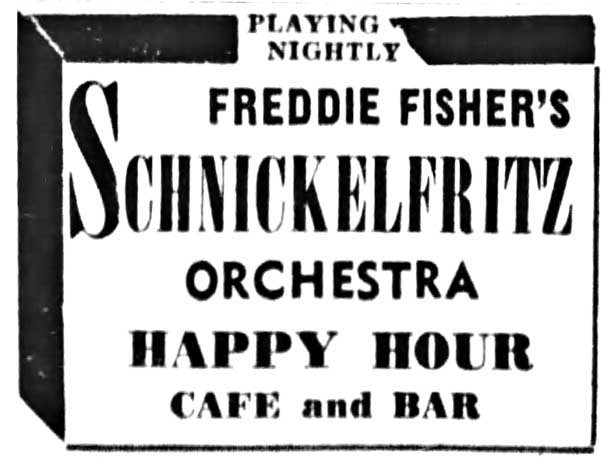
Minneapolis Tribune, October 17, 1940
1941
Abe Perkins remembered that in 1941,
each table had a clock on it – and every hour on the hour we gave away a bottle of champagne, imported champagne. That’s why we called it the Happy Hour. We used to have four cooks in the kitchen and it was open until midnight. (Minneapolis Star, May 12, 1977)
Starting on December 21, 1941, and continuing through January 1942, Walter Fuller, the “King of Jive,” performed with an a “Giant All-Star Colored Review” that included:
- Nelda Du Pree, “Sensational Creo Vocalist”
- The Three Businessmen of Rhythm
- Lon Chaney, “The Wizard Contortionist
- George Gould, “Dynamic Master of Ceremonies and Tarza???”
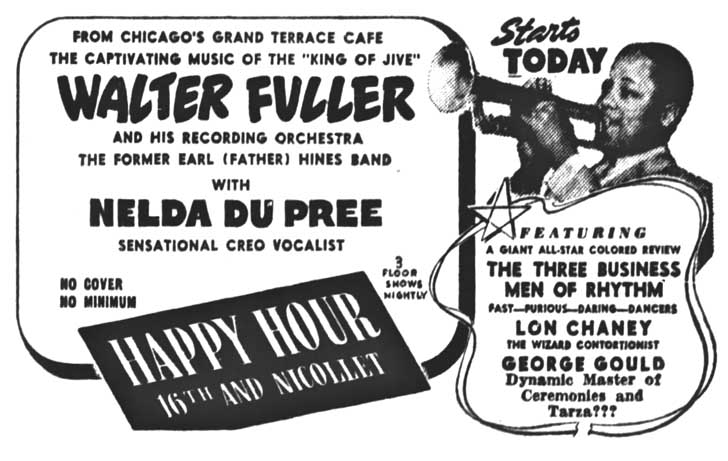
Minneapolis Star, December 21, 1941
1942
The club scored a coup by booking Fletcher Henderson for at least a week in June – July 1942.
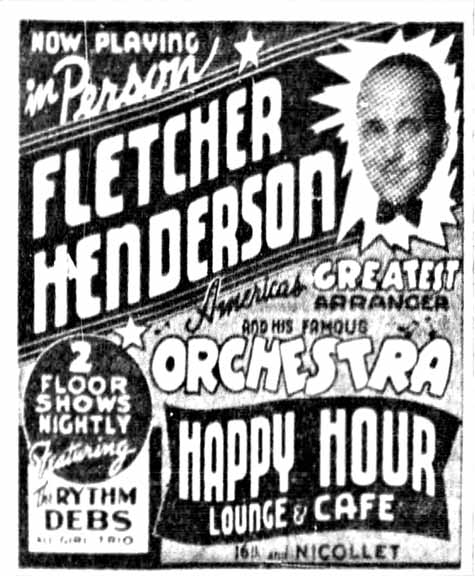
Minneapolis Tribune, June-July, 1942
A VERY STRANGE STORY
On November 23, 1942, Pvt. Harold Bartholomew went to the men’s room at the Happy Hour and encountered one Larry Dugan, alias Harry Bever, civilian. Bever’s gun fell out of his pocket, and Bever was somehow compelled to say, “I’m tough.” Pvt. Bartholomew, perhaps unwisely, responded, “If you’re so damn tough, why don’t you join the Army and do some fighting?” So Bever shot him in the jaw. (Minneapolis Star Journal, November 24, 1942)
Bever and his two fellow thugs were captured and sent to prison in Cincinnati for trial for a bank robbery there. They escaped with two kidnappers on February 12, 1943, and Bever was picked up in Amarillo, Texas, on July 24, 1943, in a roundup of suspects in the murder of an Amarillo cafe man. It turned out that he was a deserter from the Army, and he was also convicted of the murder by a general court martial, although he denied the murder. He was hanged at Fort Sill, Oklahoma, in October 1944. (Minneapolis Tribune, October 9, 1944)
Bartholomew then sued the club for serving drinks to Bever, until he became “highly intoxicated, vicious, reckless, ugly and abusive,” seeking $50,000 in damages from the owners of the bar. Witnesses who were employees of the bar were discredited by giving conflicting testimony as to who was drunk, if anyone. The jury awarded Bartholomew the full $50,000, “one of the largest verdicts ever returned in a Hennepin county district court civil action,” reported the Minneapolis Tribune on December 8, 1944, but the amount was reduced by the court to $40,000. This was further reduced to between $15,000 and $20,000. (Minneapolis Tribune, July 17, 1945 and February 28, 1950)
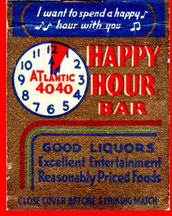
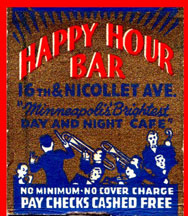
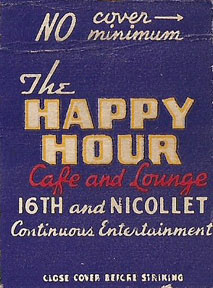
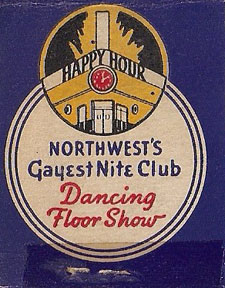
The musicians below may be the Jay McShann band.
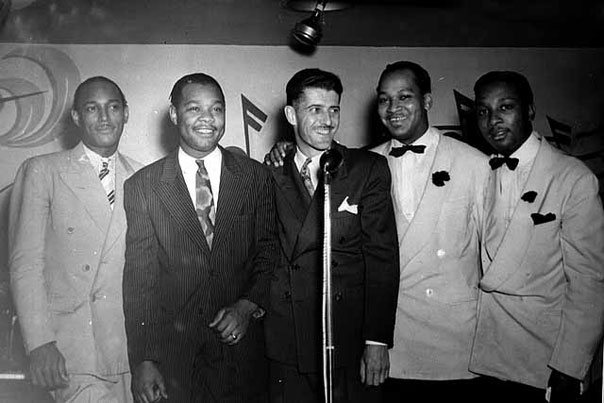
Musicians at the Happy Hour, July 18, 1942. Image courtesy Minnesota Historical Society
1943
Tiny Hill weighed in at 365 pounds and was known for a 1925 song called “Angry,” which doesn’t sound a bit angry…
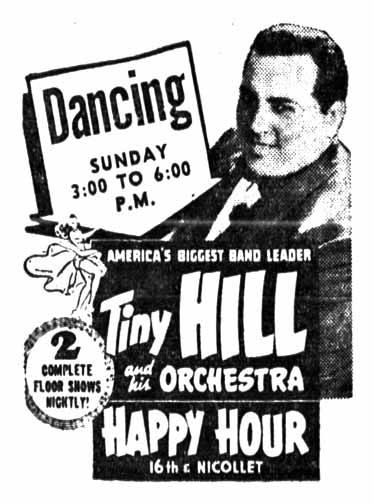
Minneapolis Star, March 19, 1943
1944
In 1944 the acts appear to have devolved to vaudeville and showgirls.
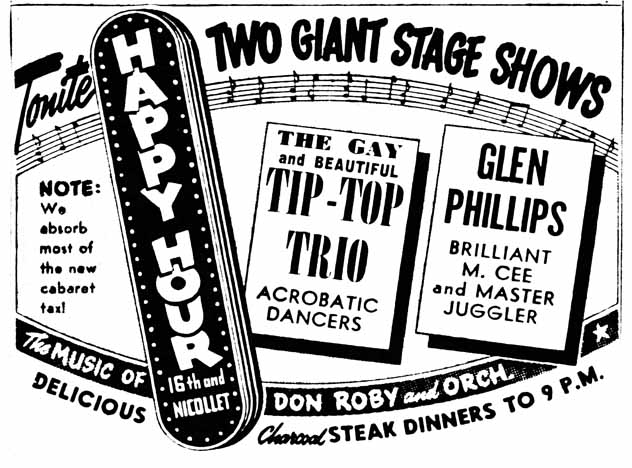
Minneapolis Tribune, July 2, 1944
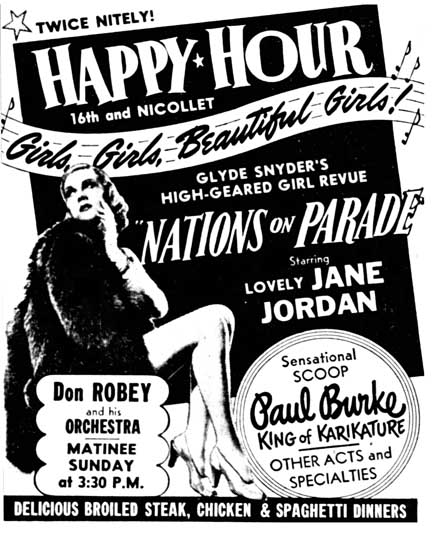
Minneapolis Tribune, October 4, 1944
1946
By the end of the War, the women bandleaders were probably very accomplished.
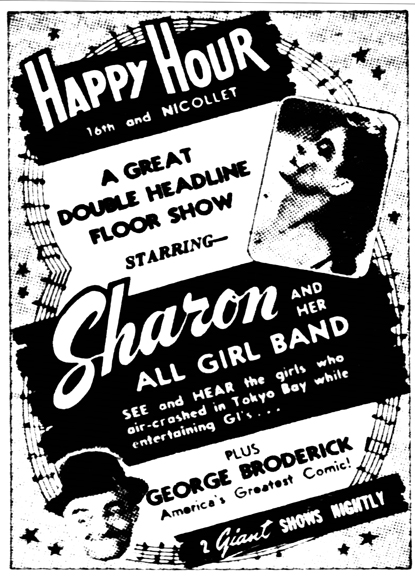
Minneapolis Star, June 21, 1946
Here’s another big orchestra leader.
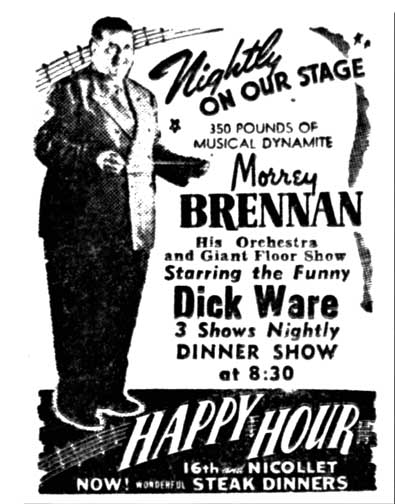
Minneapolis Star, October 11, 1946
1947
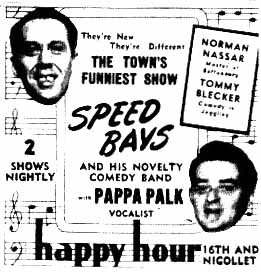
January 21, 1947
The photo below is way too dark, but Pappy Trester and his Famous Screwballs were on par with Freddie Fisher’s Schnickelfritz Orchestra – more Cornball music that was all the rage in the 1940s.
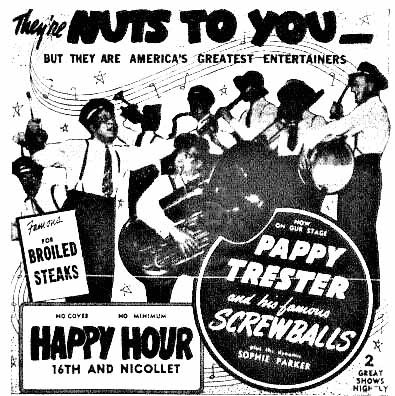
Minneapolis Star, February 13, 1947
The Screwballs were either back or still there in September 1947.
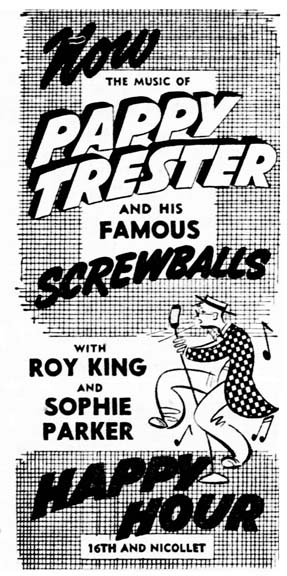
Minneapolis Tribune, September 1947
FIRE AT THE HAPPY HOUR
On November 5, 1947, at about 7 pm, fire broke out at the club, killing one fireman. Henry A. Obinger was one of nine firemen inside the building when the ceiling collapsed. The fire started in a glass-enclosed kitchen where a cook had just lighted a gas broiler. Flames flared up and ignited the grease chute over the broiler, into a small attic over the bar. Smoke drove about 50 patrons into the street. The ceiling collapsed after about 20 minutes, showering plaster and laths on the firemen. Three alarms were called to fight the fire, and spectators had to be roped off. (Minneapolis Tribune, November 6, 1947)
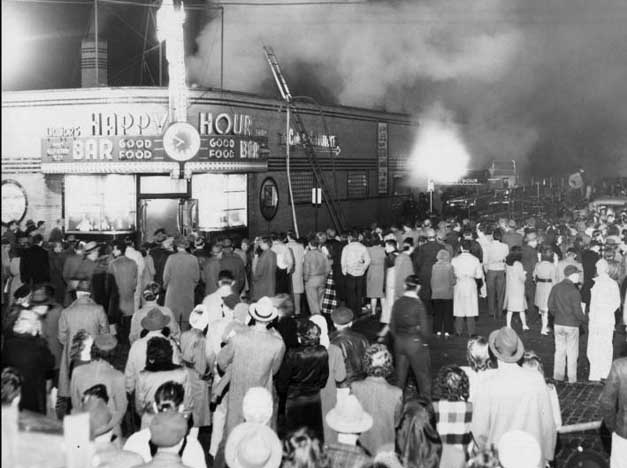
Photo courtesy Hennepin County Library
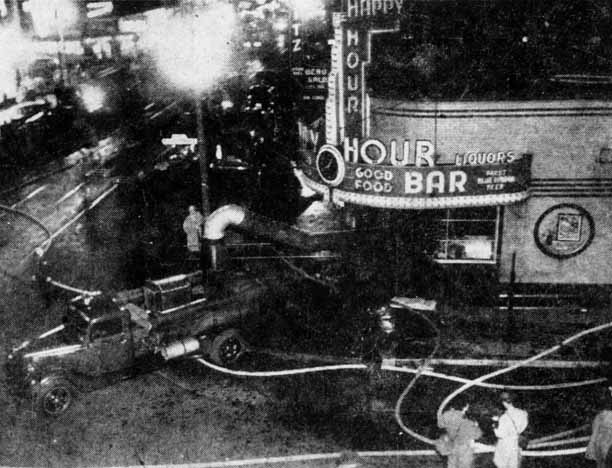
Minneapolis Star, November 7, 1947
And that was the end of the Happy Hour Cafe.
RECONSTRUCTION
When it came time to rebuild, the first order of business was to make the ceiling stronger. A catastrophic fire at the Cocoanut Grove nightclub in Boston on November 28, 1942, was the deadliest nightclub fire in history, and second-deadliest single-building fire in American history, claiming 492 lives. After that fire, construction laws were changed, and the Happy Hour’s ceiling could not have been built the way it was after 1942. All agreed that the reconstructed building must have higher construction standards.
During reconstruction, in December 1947, a 34′ by 50′ concrete and steel addition was built at an approximate cost of $15,000, according to the building permit.
Air conditioning was added in January 1948 at a cost of $10,000.
CLUB CARNIVAL
1948
BALLYHOO FROM CEDRIC
Cedric Adams was the first to announce that the club would have a new name – “The Carnival” – and a new policy of name bands with big price tags,
which show you that the refurbished Sixteenth street place is out after the carriage trade. The new interior will amaze you. The decorations will be elegant but subdued. The seating capacity will be shoved up to over 1,000. Tentative date for opening is April 1. The management says it will be one stab to see whether Minneapolis and the Upper Midwest will be willing to support the top bracket of entertainment offerings. We’ll all be interested in the outcome. (Minneapolis Star, January 29, 1948)
On March 29, 1948, Cedric gushed over the place again:
If ever a spot has been “done over” it’s the Club Carnival. Only residual trace of the Happy Hour is the location and the outside walls. The Seben people, designers and architects, began immediately following the fire and ripped the old place apart. Awaiting the grand opening will be really quite an elegant little supper club. Maybe “little” isn’t the word. It’ll seat 450 people.
He describes the Front Bar:
From the entrance on Nicollet you go into a cloverleaf stage bar done in walnut paneling. Carnival characters are in relief against a canvas background on the walls. A three-piece stage unit will entertain from 5 pm on here …
THE HYDRAULIC STAGE
Then he describes the Main Room, which he calls the Fiesta Room. It was at this point in the club’s history that the hydraulic stage was installed.
The Fiesta room (in the rear) will feature a hydraulic stage that rises [four feet to be] even with the bandstand. The stage is a section of the dance floor. The rise gives everyone of the 450 guests perfect vision of the entertainment. Indirect lighting, rheostat-controlled, will give off almost every color of the rainbow for effects. Innovations include a waitress signaling system, backs of booths that rise to the ceiling, a glass wall done in tubular mirrors, a backstage decorative effect that has 2,000 individual lights.
Top budget for entertainment is $7,500 a week which means there’ll be quite a nut to crack. Very few bookings in the first 13 weeks of the present schedule run lower than $6,500. It’ll be interesting to see how Minneapolis reacts and whether the community will support offerings in this bracket. With rooms and clubs closing all over the country under economic pressure, this type of expansion is indeed unusual. April should tell the story.
Mildred Percansky was no longer an officer on the board of Ramona Cafe, Inc., which held the liquor license. The new officers were Ted Cook, manager and president; Ruth Cook, secretary and treasurer; and Gordon F. Gertz, Vice President.
(Interestingly, Yiddy Bloom’s probation officer said that Yiddy (Kid Cann’s brother) was the manager of the club!)
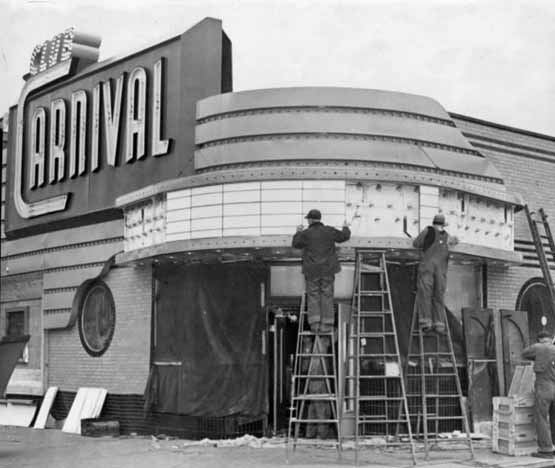
Putting up the sign at the last minute, April 8, 1948. Photo courtesy Hennepin County Library
OPENING NIGHT
The Club Carnival Night Club opened on April 8, 1948. Frankie Carle and his band were the first to entertain.
Cedric’s report was glowing:
Last vestiges of the old Happy Hour vanished last night with a grand opening of the new Club Carnival in the spot on Sixteenth and Nicollet. Some 700 guests thronged into the two new rooms that make up the Club Carnival and opinion seemed to be unanimous that the layout is fully as elegant and glamorous as anything between our two coasts. Outside of a few opening night bugs, little things that are expected to go haywire, nothing but complimentary remarks could be heard for the new surroundings, the new policy, the latest addition to the city’s night life.
Seating arrangements are perfect, the stage that rises gives excellent vision, the dance floor seems amble and the entire surroundings reflect taste – good taste. The management couldn’t have selected a better band than Francie Carle’s for the opening. The maestro was exceedingly generous with his Carle classics. His little rhythm section brought howls of approval from the packed house. It’s a joy to listen to the Carle outfit with an intimacy you don’t get in a theater. If the success of an opening night is at all indicative of the future, Club Carnival is very apt to slide into the No. 1 spot locally. (Minneapolis Star, April 9, 1948)
Adams continued to report on the success of the club, saying that Frankie Carle played to capacity houses for his entire week’s run, which added up to 400 people per night in the Fiesta (Main) Room and 600 packed into the Front Lounge. The next act was Hal McIntyre, which was odd, because there was a “national” Hal McIntyre and a “local” Hal McIntyre. While “national” was here, the two Hals got together for a nice chat. (Record fans knew the difference.) Reservations for the club were coming from as far west as Idaho and as far east as Ohio! (Minneapolis Star, April 20, 1948)
ACTS AT CLUB CARNIVAL
The following are the acts, as best I could find, that appeared during the short tenure of the Club Carnival. I will post ads of the bigger names, and merely list some of the smaller, or at least the more common bands that have appeared at other venues around town, such as the Prom and Marigold Ballrooms. Dates are not all inclusive – I’ve tried to capture opening nights, but I can’t guarantee that I have. Some ads, though fabulous, were just too dark to translate to the screen. Those lucky enough to have caught these name acts at the Club Carnival before it went broke must have remembered those nights forever!
The Blue Barron Orchestra followed Frankie Carle with a two-week engagement – piano star Jan August was featured. The sports page reported that on May 6, 1948, Mr. Barron and his 14-man band will take over the St. Louis Park driving range in a “mass attack exhibition” at 3 pm.
Clyde McCoy and His Orchestra; Jimmy Ray, America’s Most Unusual Dance Act; and The Madcaps, Musical Comedy Twins: May 1948. Oh, perhaps in appreciation for his kind remarks about the club, in the early days, shows featured the winners of Cedric Adams’ “Stairway to Stardom” show. Such were the Madcaps.
The Charlie Spivak Orchestra with the captivating Irene Daye; Gorgeous Dance Sensation Nancy Bell; and Star Impersonator Frank Payne, winner of, well… : June 1948.
Nick Stuart and His Orchestra, featuring Jeff Swift; The 3 Lind Brothers; the Gorgeous Dolly Barr, Loveliness in Syncopation; and the unnamed winner of Cedric’s: July 1948.
Professor Backwards, Dean of Laughology; Sonny Howard, Arthur Godfrey’s Singing Discovery; and on Monday nights, dance teacher David LaVay gave Rhumba lessons. And Cedric. December 1948.
Matchbook below from the Collection of Mark Youngblood
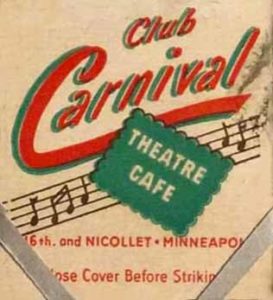
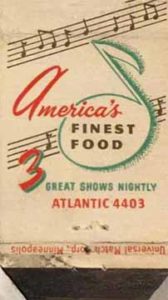
1949
Harry Cool and His Orchestra; The Charioteers, from the show “Hellzapoppin;'” and Janet Lynn, Dancing Unique. No Cedric. January 1949.
Gil Lamb, Minneapolis’s own Rollicking Star of Motion Pictures; Perry Martin and His Orchestra; and Helen Forrest, voice of 10 million records: February 1949.
Nellie Lutcher, the “Real Gone Gal:” opening March 3, 1949. Now I would definitely go see Nellie!
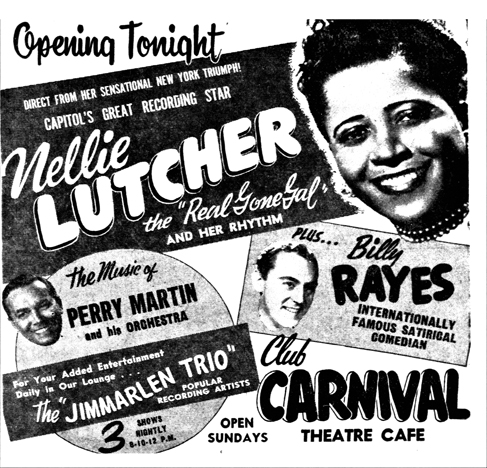
Minneapolis Star, March 3, 1949
Vivian Blaine (remember her from “Guys and Dolls,” which hadn’t been made yet); Hal Fisher, Your Laff Salesman: March 20, 1949
Perhaps the first really big star was Martha Raye, with the Ben Yost Singers: March 31, 1949
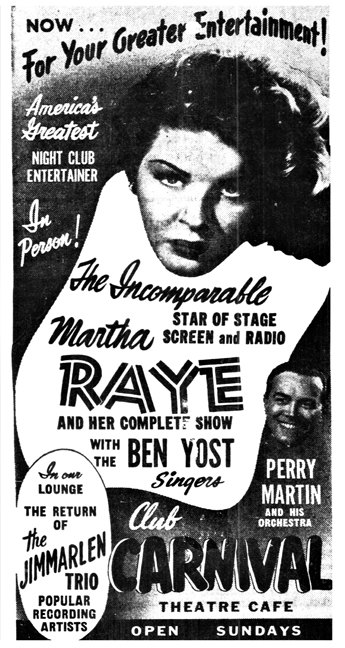
Minneapolis Star, March 31, 1949
Cedric Adams reiterates the Club Carnival’s big name policy and success in his column in the Minneapolis Star of April 28, 1949:
Name acts only is the new policy at Club Carnival in Minneapolis. After the management finished paying Martha Raye her $6,000 per week, it found the bistro operating in the black so then and there decided on nothing but stars and big stars. Apparently it has been discovered that Minneapolis patrons will flock to good entertainment but stay away in droves from the mediocre.
Mel Torme and Comedienne Jean Carroll, April 28, 1949
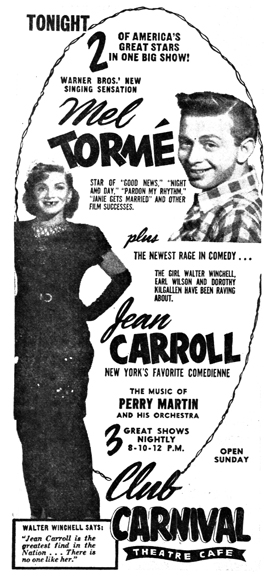
Minneapolis Star, April 28, 1949
Romo Vincent, America’s Singing Comedian; and Borrah Minevich’s Harmonica Rascals: May 19, 1949.
Sophie Tucker, the Queen of Entertainment, with Ted Shapiro at the piano. Exclusive songs by Jack Yellen. Also Folie Miller, Dance Stylist and Martin Barnett, Comedy Magic: June 5, 1949.
The Ink Spots, with Dance Stylists Son and Sonny: June 9, 1949
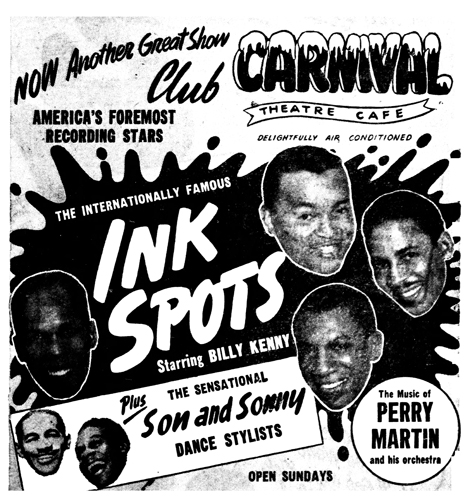
Minneapolis Star, June 9, 1949
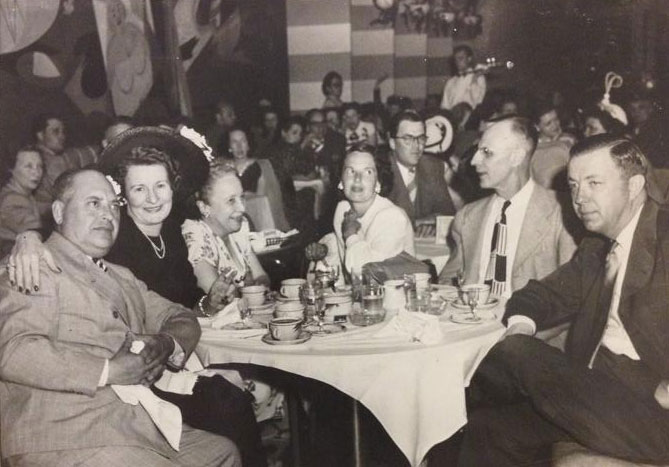
Revelers at the Club Carnival enjoying the Ink Spots, 1949 – posted by Tracy Wych

This folder with evil clown on the back courtesy Tracy Wych
Harry Richman, America’s Greatest Entertainer, with Joe Harnell at the Piano. Also the riotous Laurette and Clymas, Scintillating Comedy Stars : June 23, 1949
Joan Edwards from “Your Hit Parade,” playing her songs from the piano. Also Buddy Lester, Television’s Gift to Great Comedy and Funny Man of the Year. Plus Betty Hill in Modern Dance: July 24, 1949.
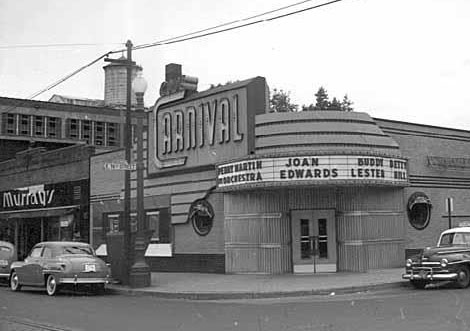
1949 photo from Minnesota Historical Society
Cab Calloway: August 4, 1949
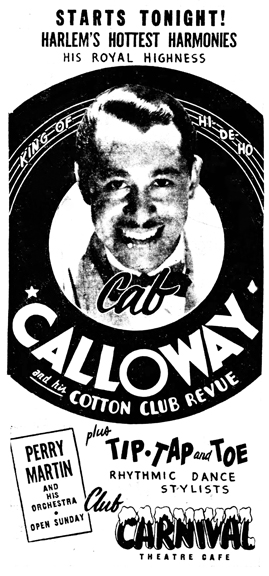
Minneapolis Tribune, August 4, 1949
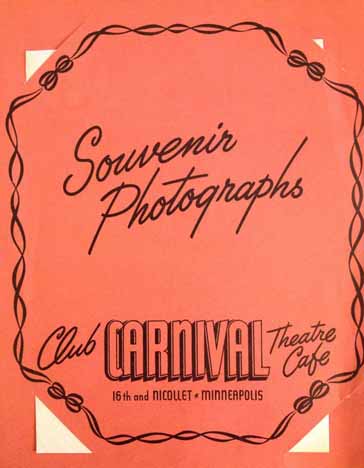
This folder came with a picture of Cab Calloway. Courtesy Tracy Wych
Harvey Stone, Star of Stage, Scream, and Raveyo; and Frances Faye, “Queen of Clubs,” New York’s Newest Comedienne: August 21, 1949.
Lena Horne, with Comedian Sonny Mars: September 1, 1949
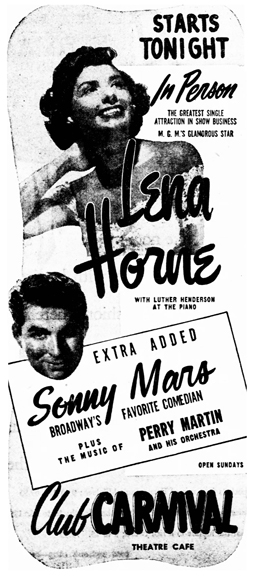
Minneapolis Tribune, September 1, 1949
King Cole Trio with Comedian Willie Shore: September 20, 1949

Minneapolis Star, September 22, 1949
The King Cole Trio got a rousing review from John K. Sherman, who revealed that the Trio was really a foursome with the addition of Jack Constanza on Cuban drums. (Minneapolis Star, September 22, 1949)
Ted Lewis; September 27 into November, 1949. His world-famous orchestra and giant revue, featuring:
- Geraldene Du Boise
- The 3 Reed Sisters
- Meribeth Olds
- Paul White & Elroy Peace
Beatrice Kay, Gay Nineties Girl; Jan August and his piano music: November 24, 1949.
1950
Connee Boswell, Impressionist Dean Murphy, and singing Emcee Al Grant: January 8, 1950.
The Ritz Brothers began a 13 day run on January 13, 1950. On the bill were the Sensational Maxellos, the singing Emcee Al Grant, and the Club Carnival Orchestra.
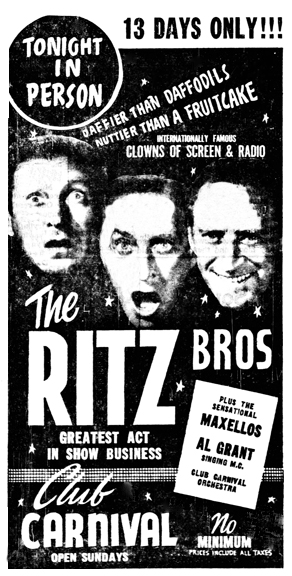
Minneapolis Tribune, January 13, 1950
Sophie Tucker was back on January 26, 1950, with comedian Vic Eyde and the Bob Locken Orchestra.
Carmen Miranda with her Bando Da Lua, Comedian Gary Morton (Lucy’s husband), Emcee Dick Gordon, the Club Carnival Orchestra, and Carmen Garcia and Her Rhumba Band: February 9-22, 1950.
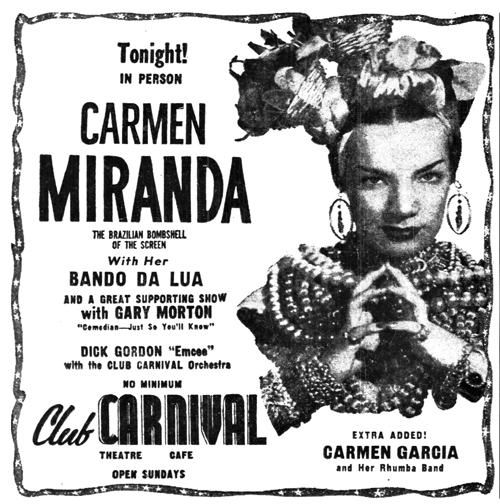
Minneapolis Star, February 9, 1950
Delta Rhythm Boys, Asian movie star Keye Luke, modern tap dancer Vera Love, Carmen Garcia and Her Rhumba Band, with Dick Gordon and the Club Carnival Orchestra: February 24, 1950.
Martha Raye made a repeat appearance with the Ben Yost Singers and the Bob Locken Orchestra on March 9, 1950.
The Mills Brothers, with Comedian Ray English and Bob Locken’s Orchestra: March 23 , 1950.
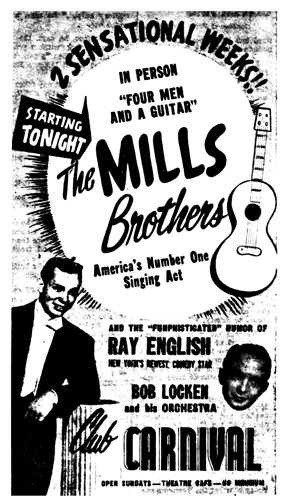
Minneapolis Tribune, March 23, 1950
On April 6, 1950, Peggy Lee came with her own Quartette, and Comedian Billy Rayes. Bob Locken’s was apparently the House Orchestra. Business had been waning, but on April 7, 1950, the Club took off its cover charge and things picked up. (Minneapolis Tribune, April 17, 1950)

Minneapolis Tribune, April 7, 1950
Mel Torme made a repeat performance, again with Jean Carroll, now billed as the “Female Milton Berle.” Bob Locken and His Orchestra: May 7, 1950.
Dorothy Donegan, Broadway’s Newest Sensation, America’s Dynamic Piano Personality. With Charley Chaney, Comedy Star of Radio and TV and the Dorothy Dorben Dancers. Bob Locken’s Orchestra: May 25, 1950.
Sarah Vaughn, with Comedian Paddy Brown: June 11, 1950.
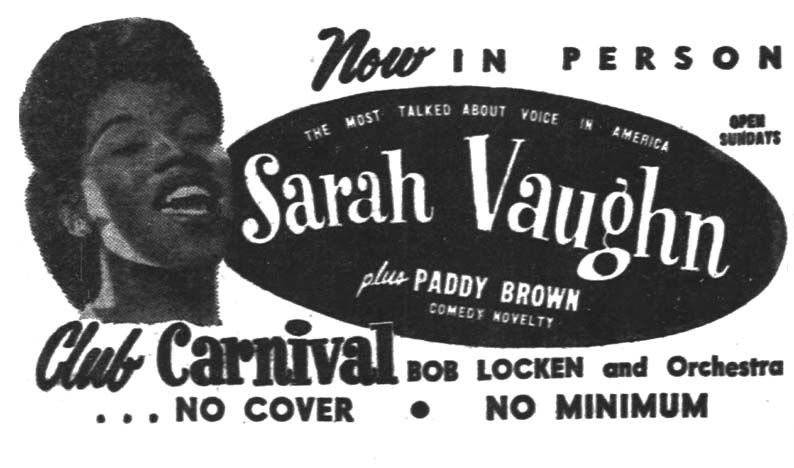
Minneapolis Tribune, June 11, 1950
RUMORS ARE FLYING
Rolf Felstad of the Minneapolis Tribune reported on rumors that the Club Carnival was going to shut down and that its liquor license would be moved to the Flamingo Bar, 1 E. 26th Street, then a 3.2 tavern. This rumor was hotly denied by the Ramona Bar and Cafe, Inc., holder of the license.
Cook said that the Ramona had a lease that had two and a half more years to run. However, they had been discussing modifying their entertainment policy, although they had name acts booked through May. Rumor had it that the club was losing up to $150,000 a year, although it hadn’t even been open for a year. It also reported that in the Happy Hour days,
as now, it was the happy and frequent haunt of Kid Cann, long a leading figure in lower Minneapolis society. (February 18, 1950)
Despite Cook’s insistence that the club wasn’t going to move, a petition with 1,500 names was submitted to the City Clerk opposing the transfer of the Club Carnival’s liquor license to the site of the Flamingo Cafe, signed by members of the Whittier neighborhood. The article implied that there was application had indeed been submitted. (Minneapolis Tribune, April 4, 1950)
THE CARNIVAL’S OVER
As it turned out, the Club Carnival shut down in June 1950. Its attempts to bring national acts to Minneapolis had resulted in high prices and cover charges, which led to its downfall. (Will Jones, Minneapolis Tribune, February 7, 1951) Its liquor license was transferred to 1504 East Franklin Ave. (Addison’s Bar, where the assistant manager was none other than Yiddy Bloom, Kid Cann’s brother!) The plan was for Albert L. Addison to have his beer license transferred to the 16th and Nicollet location, which was approved on June 30, 1950, but Addison never picked up the license.
THE FLAME CAFE
1951
By January 18, 1951, the Club Carnival sign was down and the new Flame sign was up on the building at 1523 Nicollet, although the transfer of the licenses had not been finalized. Samuel Markowitz was identified as the assistant manager of the Flame. Markowitz had applied for the 3.2 beer license held by Albert Addison at the Carnival but not used. (Minneapolis Tribune, January 18, 1951)
In 1951 the license of the original Flame Theatre Lounge, which had been located at 1607 Nicollet across 16th Street on the same side of Nicollet, was transferred here to 1523 Nicollet.
MY OLD FLAME?
Will Jones dedicated most of his February 7, 1951, column in the Minneapolis Tribune to the new Flame Cafe, due to open the following Wednesday. He described it as just a continuation of the original Flame Theater Cafe at 1607 Nicollet, “a night spot featuring dancing girls in scanty costumes and accompanying glitter.”
He also described Ray Percansky as merely the owner of the building, who would “be on hand for a few months to help the new tenants launch the place with an atmosphere to be patterned after such flashy eastern establishments as the Copacabana and the Latin Quarter.”
The new Flame will offer three shows a night. There’ll be a line of six of the above-mentioned dancing girls, assorted vaudeville acts and an orchestra. There’ll be a new show every two weeks. Glyde Snyder will produce. Acts will be brought in from New York and Chicago, but there’ll be no attempt to re-establish the big-name policy which reportedly lost large chunks of money for the Carnival, Perkins said. The Carnival name is being abandoned along with the high prices and cover charges associated with it, he said.
“There hasn’t been a real good hoop-la place in town for a long time,” said Perkins. “I think we need it.”
THE FLAME IS LIT!
The opening show on February 14, 1951, featured:
- Bobby Baxter, “Hilarious Funster and TV Star” (Might be this magician)
- Harriet Blake, singing comedienne
- Kathryn Leigh, “Singing Sweetheart of the Air Waves”
- LeRoy Fisher’s Orchestra
- The Glorianna Dancers
- Johnny Simmons, singer and M.C.
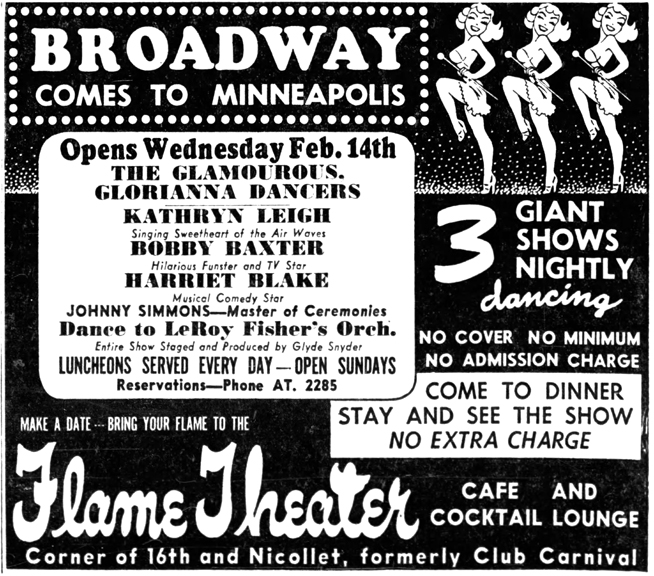
Minneapolis Tribune, February 1951
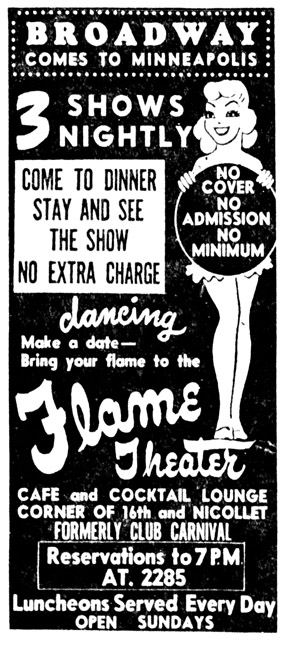
Minneapolis Star, February 22, 1951

Minneapolis Tribune, April 20, 1951
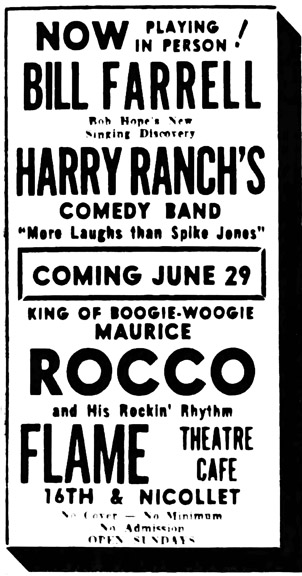
Minneapolis Tribune, June 24, 1951
In December 1951, the Flame inaugurated a new vaudeville policy, and for the occasion recruited a band capable of sweet, Dixieland, or advanced jazz. Personnel included:
- Marvin Dahlgren, drummer and percussionist with the Minneapolis Symphony Orchestra
- Rufus Webster, pianist with a master’s degree in music from the University of Minnesota
- Charles Beasley, sax, graduate of the MacPhail School of Music
- Irv Williams, leader, veteran of the Count Basie and Billy Eckstine Orchestras.
Minneapolis Tribune, December 2, 1951
1952
JAZZ CAROUSEL
In January 1952 the Flame began to program jazz on Sunday nights, a show called “Jazz Carousel,” produced by bandleader Bruce Dybvig. Both Dixieland (Harry Blons) and modern (Percy Hughes) jazz were presented. In October 1952 the Four Notes were ongoing entertainers.
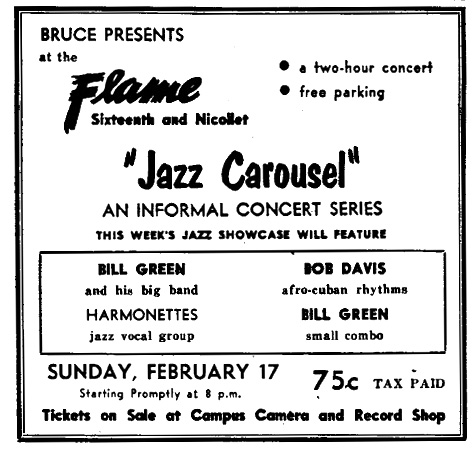
Minnesota Daily, 1952. Courtesy Robb Henry
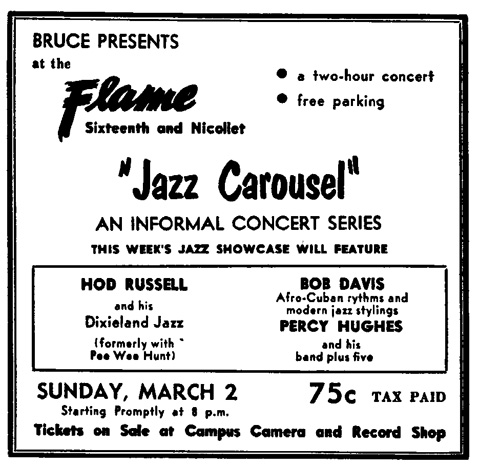
Minnesota Daily, 1952. Ad courtesy Robb Henry
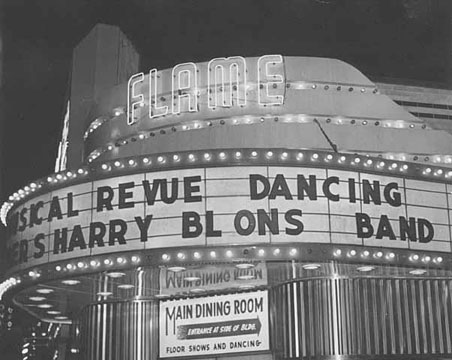
In 1952 the Flame was the “House of Music,” seemingly bringing in a better class of music to the stage.
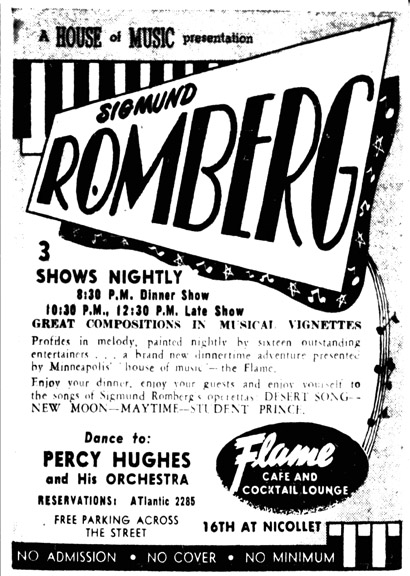
Minneapolis Star, May 2, 1952
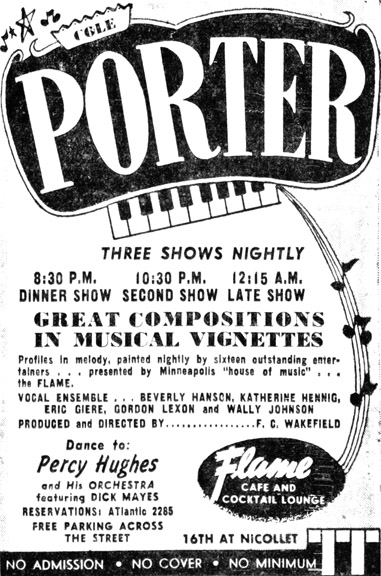
May 30, 1952
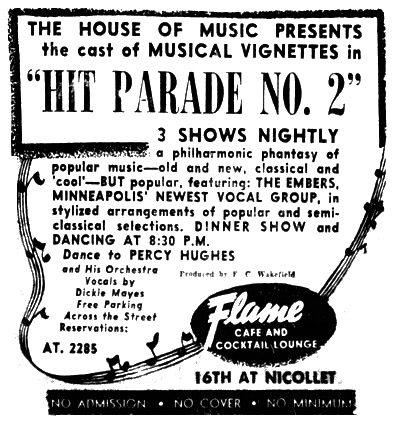
July 18, 1952
This show in September 1952 indicates that the floor show was back.
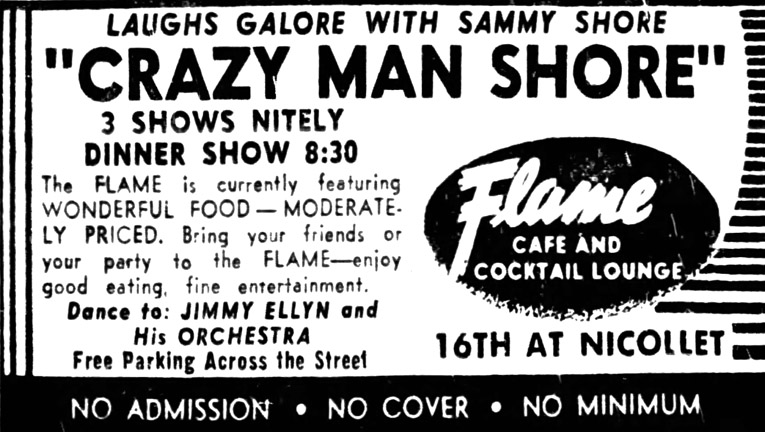
Minneapolis Star, September 12, 1952
In October 1952 an article on liquor licenses indicates that Mrs. Freda Swartz, 2716 Drew Ave., was the former operator of the Flame at 1523 Nicollet. Freda was the sister of Kid Cann’s wife.
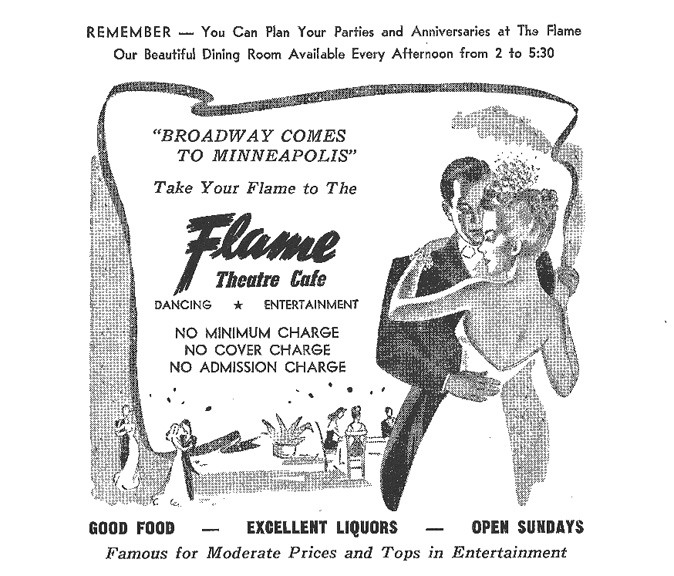
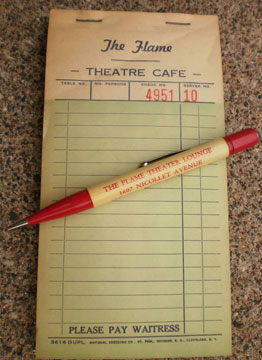
WHERE’S MY HUSBAND?
In October 1952, you could register for $2,000 in Wonderful Prizes by naming the Flame’s “Mystery Husband!” 12 clues were given out over WTCN radio. To register, you had to go to the Flame on Monday, Wednesday, or Friday between 2 and 5 pm, where you were urged to stay for a Cocktail Lunch. “Where’s Your Husband?” was a new radio show broadcast over WTCN radio from the Flame, featuring DJ Sev Widman.
1954
Confusion reigned over the Flame’s application to renew its liquor license. The names on the original license were:
- Frank M. Connor
- Mabel Rails
- Ida Beell
- Joseph E. Connor
- Vienna Niemi
- Irene Bodine
The 1954 application came in without the first two names, making the license committee wonder if this was a renewal or a new application. It mattered, because new applications had been frozen.
Here in mid-1954 there are no T-Bone steaks as yet, but dinner is still cheap!
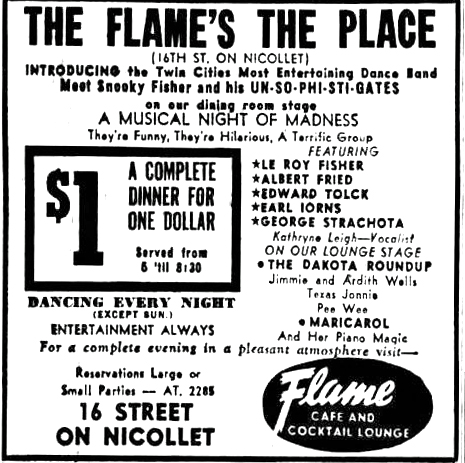
June 11, 1954
The ad below indicates that in August 1954 the Flame was still trying to find its identity. It may also be the start of the Flame’s famous T-Bone Steak Dinner.
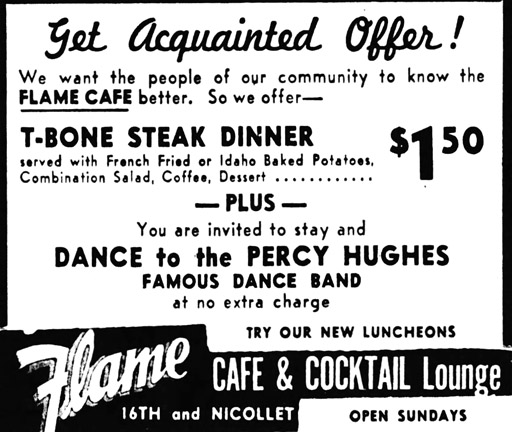
August 24, 1954
The Flame was not yet the Flame. Will Jones writes of strippers in his September 23, 1954, column – specifically “Taika” at the Flame, who walks out into the audience on a runway. “We’re giving ’em 3-D,” said Raye.
Taika dances barefooted. She has been in the habit of sneaking throught the audience in the darkened club, slipping off her shoes at the audience end of the runway and suddenly making her appearance in the midst of the people as the lights flash on. Twice somebody stole her shoes from the end of the runway. Now she leaves her shoes in her dressing froom and gropes among the tables bare-footed to make her trick entrance.
Will Jones item in the Tribune, December 17, 1954:
Percy Hughes is going in for semi-classical dinner music during the early hours at the Flame. “Call me Percy FAITH Hughes,” he requested. Rufus Webster’s piano has been wired so it sparkles all the way to the back of the big room along with the full band, and the sound is good. Sophie Parker also has moved her bulk into the Flame.
Below is an image of a Sophie Parker record provided by record collector Rod Wideman. Did it belong to Sophie, or someone named Sophie Parker who lived in Minneapolis? The singer Sophie Parker was from Texas and was known as the “Kate Smith of the South,” says Minnesota record expert Derik Olson. Also see Derik’s blog.
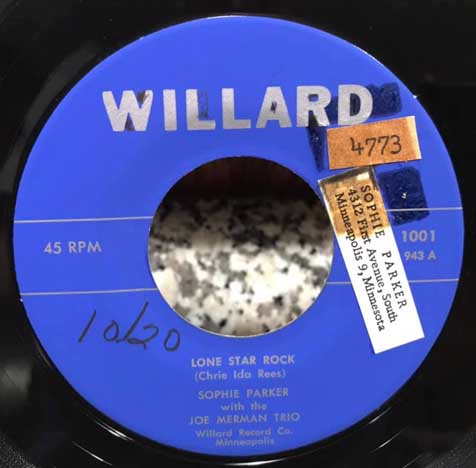
Image courtesy Rod Wideman
1955
THE JAZZ AGE
Another format shift came in 1955 when national jazz acts were booked. Each act was hired for as long as they were available, so some were at the Flame for weeks, while others just for days.
The first of these big acts was saxophone player Charlie Ventura, who was in residence for a three-week stay, from March 23 to about April 12, 1955. Will Jones was particularly smitten with Sonny Igoe’s drumming. Percy Hughes’ band played music for dancing. (Minneapolis Tribune, March 18, 1955)
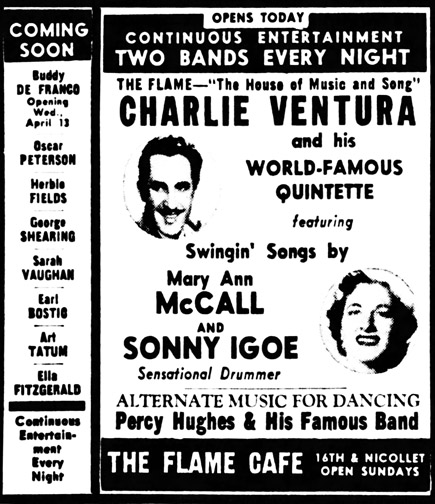
Minneapolis Tribune, March 30, 1955
Overlapping Ventura’s stand was Mary Ann McCall, substituting for the originally-scheduled Anita O’Day. McCall sang with Ventura’s band from March 30 to April 12, 1955.
After Ventura came clarinetist Buddy DeFranco, from April 13 to 26, 1955.
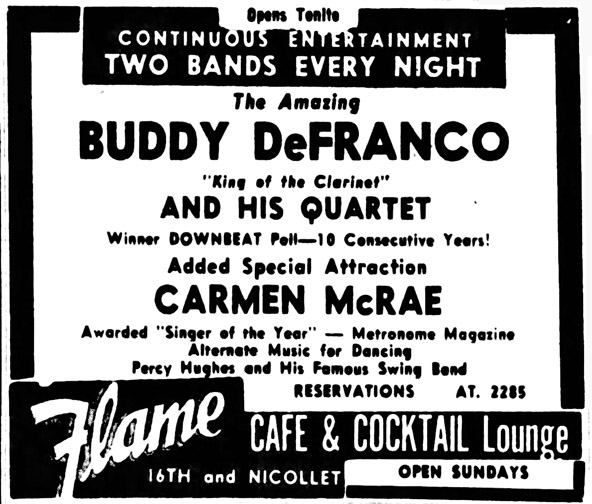
April 13, 1955
Cornet player Muggsy Spanier, the “King of the Dixielanders,” and his Sextet followed Buddy DeFranco for a week starting April 27, 1955.
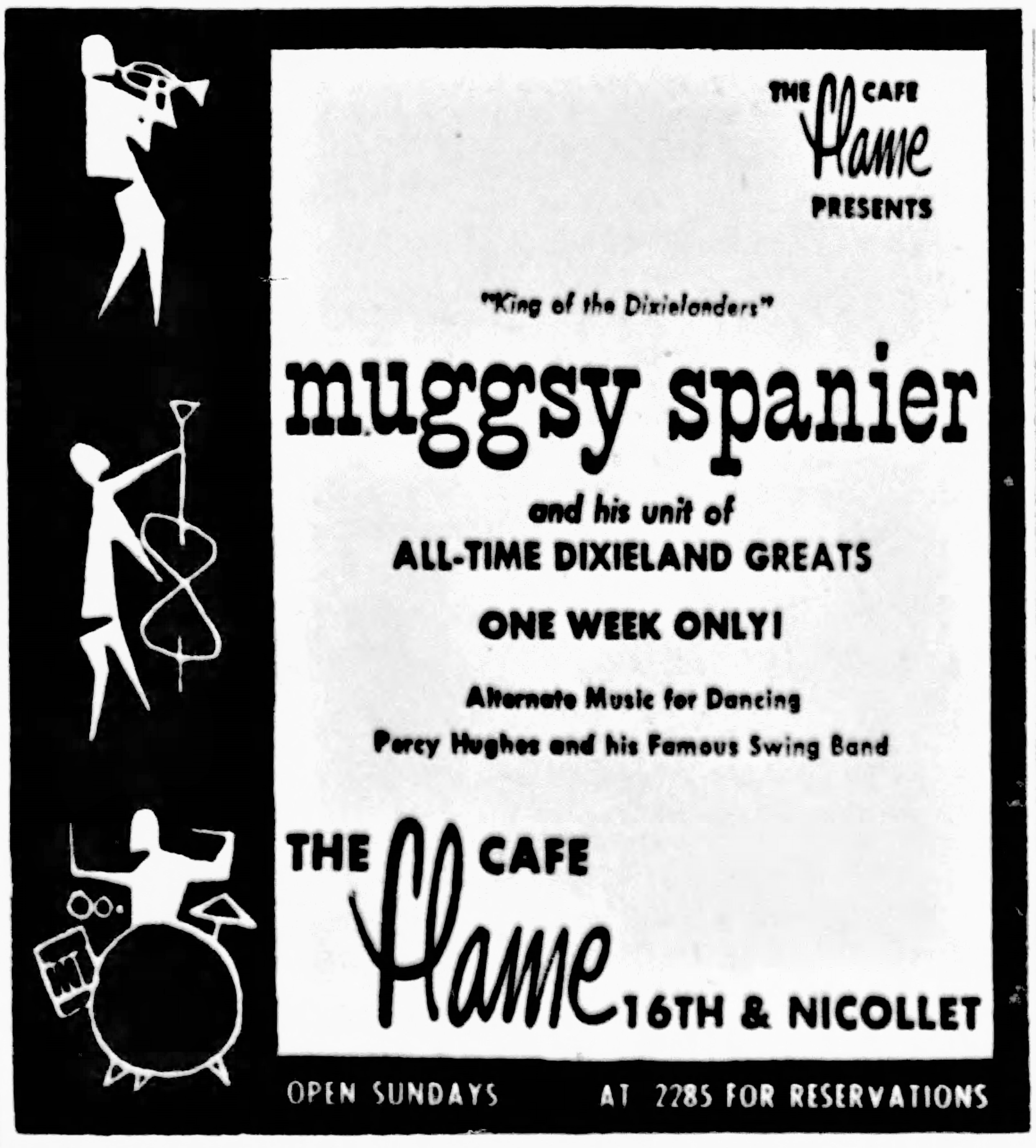
Minneapolis Tribune, April 27, 1955
Dizzy Gillespie, the “Baron of Bop,” came directly from Birdland in New York, playing the Flame from May 4 to 24, 1955. Dizzy also joined Duke Ellington at Ellington’s engagement at Northrop Auditorium on May 20, 1955. Gillespie’s band consisted of:
- Dizzy Gillespie: trumpet
- Wynton Kelly: piano
- Charles Persip: drums
- Sahib Shihab: baritone sax
- Nelson Boyd: bass
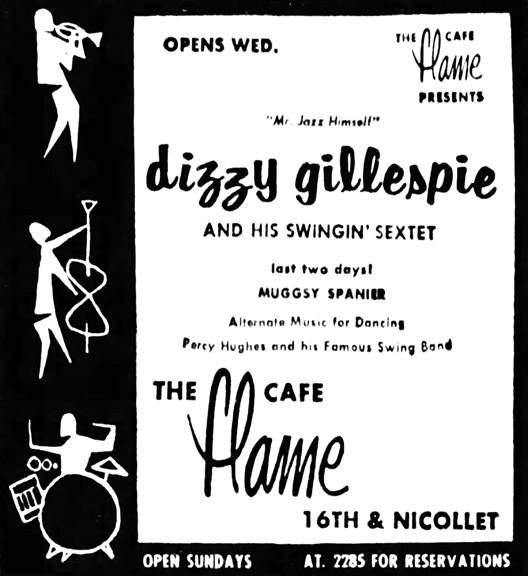
Minneapolis Tribune, May 1955
Drummer Gene Krupa and his Quartet took over from May 25 to June 5, 1955.
Then Count Basie and his 17-piece band made their first Minneapolis appearance, from June 7 – 11, 1955.
Oscar Peterson came through from June 14 to 18, 1955, with Ray Brown on bass and Herb Ellis on guitar.
Next came Sarah Vaughn, from June 29 to July 9, 1955.
Up to this time the house band had been Percy Hughes’, who also filled in on nights where no national act was scheduled. On July 10, 1955, the house band became the Oskar Nordh Trio. Nordh was on piano, Dale Olinger on guitar, and Roy Johnson on bass.
The last act that Will Jones mentioned was the Buddy Rich Quintet, on July 12 – 18, 1955. With Rich came a new jam session, scheduled for Saturdays from 3 to 5:30 pm.
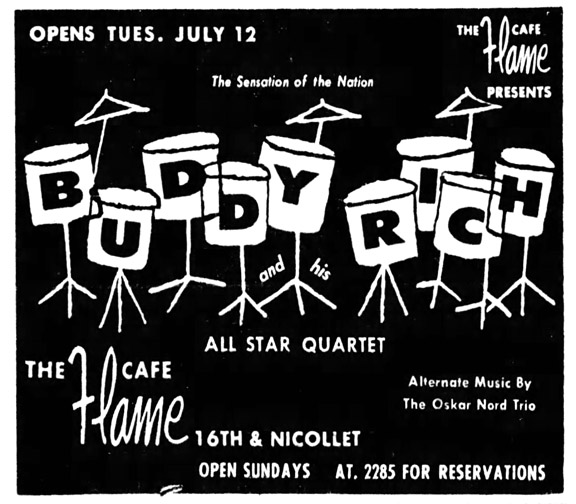
R&B saxman Illinois Jacquet began a stand on July 25, 1955.
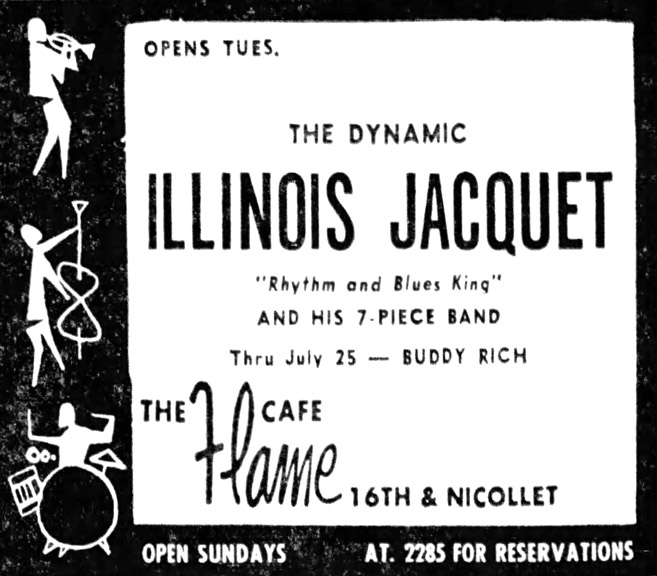
Other names mentioned during this time but may or may not have appeared are:
- Earl Bostic
- Herbie Fields
- George Shearing
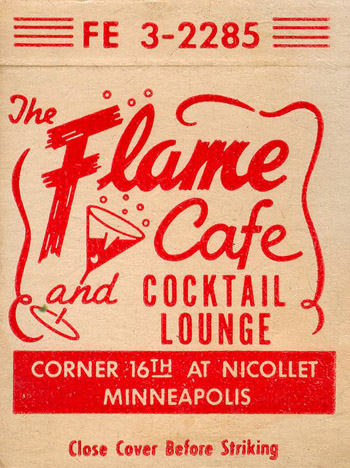
1956
THE FLAME GOES COUNTRY
In his February 1, 1956, column in the Minneapolis Star, Cedric Adams wrote:
Western music has spread out a good deal in the last few years and now it takes over a Minneapolis theater café. The Flame at Sixteenth and Nicollet experimented with a western band for a couple of nights and found the customers liked it, so now makes it regular policy. Johnny T and the Tennesseans, one of the top country and western bands, moves into the place tonight and square dancing and other hoppity steps are the rule. The Flame goes whole hog on the theme, using the Dakota Roundup troupe in the lounge, with special Wednesday night appearances by Texas Bill Strength, the hillbilly singer. Any square dance group, incidentally, can bring its own caller along, so you may hear some verbal improvisations.
On February 2, 1956, Will Jones also noted the Western trend:
Western music has been a feature of the front bar for a number of years, but it didn’t invade the big back room until last week. The management tried out Johnny T. and his Tennesseans, liked them, and hired them as an every-night attraction.
The Dakota Roundup continues in the front bar, with Texas Bill Strength as a regular Wednesday night guest.
“The Flame has become House of Western Swing – Newest Musical Fad!”
To celebrate the new musical policy, the Main room was redecorated with wagon wheels and the banquettes were covered with cowhide.
THE NEW DECOR
The photo below is of singer Dick Van Dale and local songwriter Bud Auge. It gives us a peek into the inside of the Flame in March 1961. A 1977 article describes the incongruity of the Country decor, still intact while the Main Room has turned into an R& B venue.
Cut-out figures of cowgirls wearing transparent shirts while roping cattle circle the walls. A large oil painting of an Indian shooting a buffalo hangs over the front door. Huge wagon-wheel chandeliers hang from from the ceiling.
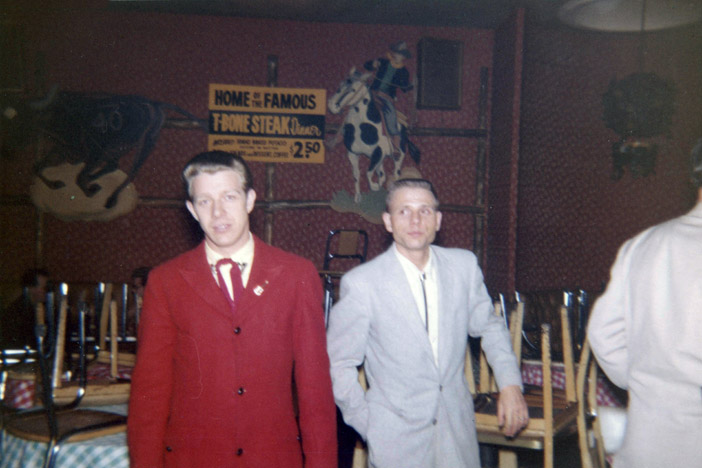
March 3, 1961
JIMMY AND ARDIS WELLS
From the time the Flame went Country, two acts were regulars in the Front Room Lounge: Ardis Wells and Her Rhythm Ranch Girls and her husband Jimmy Wells and the Dakota Roundup. Ardis Wells had an interesting life prior to her stint as a Country music bandleader.
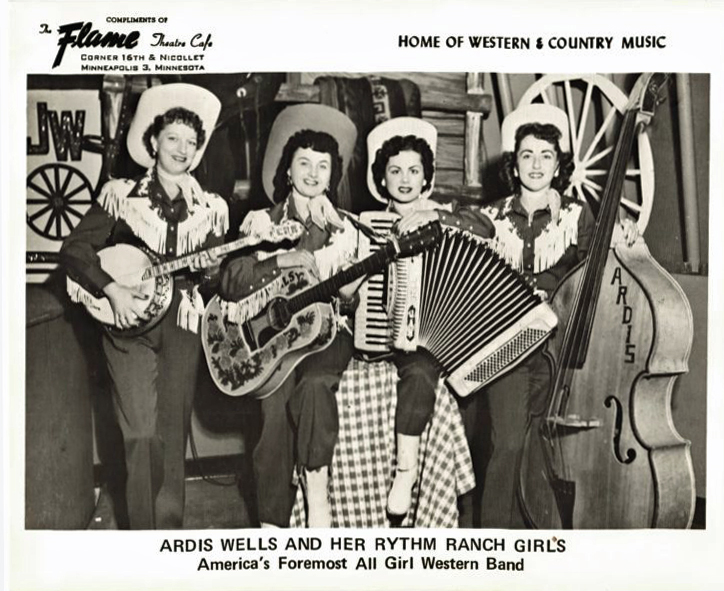
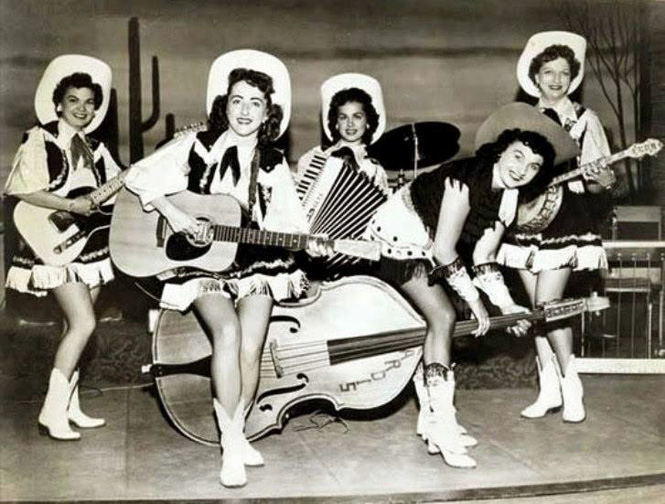
COUNTRY SHOWS AT THE FLAME
Although not complete, here is a SPREADSHEET that I hope lists most of the country performers who came to the famed Flame Cafe. TBS is an abbreviation for Texas Bill Strength, who played an important role in bringing big Country acts to the venue. Click on his name above for a much longer piece on this local singer, DJ, recording artist, and more. Additions to the spreadsheet are welcome!
The ad below may be for one of the first all-Country shows at the Flame:
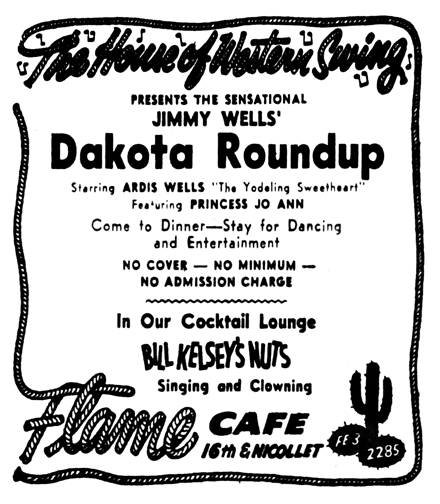
February 2, 1956
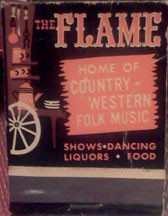
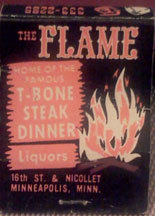
March 17, 1956, Billboard:
Jimmy and Ardis Wells and their Dakota Round-Up continue to hold forth at the Flame Supper Club, Minneapolis, where Johnny T. and His Crazy Tennesseeans carry on it the club’s rear room each Friday and Saturday night. Texas Bill Strength, now spinning the country wax over a Minneapolis station, appears as guest with Jimmy and Ardis each Wednesday night. The Flame devotes two nights a week to country music exclusively.
April 14, 1956, Billboard:
Ardis Wells and her all-girl band, the Rhythm Ranch Queens, has opened in the front room of the Flame, Minneapolis, with Jimmy Wells and the Dakota Round-Up Gang holding forth in the Flame’s rear room. Texas Bill Strength (Capitol) is a nightly guest at the spot.
TEX RITTER STARTS THE BIG NAME COUNTRY ERA
On May 10, 1956, Will Jones announced the addition of national Country stars to the Flame:
Tex Ritter, singing cowboy, will be the first of a string of western names to be booked into the Flame Café. He will appear there next Wednesday night. [May 16, 1956]
On later Wednesday nights the spot will offer Tabby West, Betty Foley, Marvin Rainwater and Bobby Lord – all of whom I have been assured are big names in the western music field. (Ritter I’m sure of, largely because of “High Noon.”)
On nights other than Wednesday, the Flame is still all-western, with Ardis Wells and the Rhythm Ranch girls in the front bar, and Jimmy Wells and the Dakota Roundup in the back room.
In reviewing the Tex Ritter show, Will Jones reported that Ritter did his show in the Main Room, then moved to the Front Room, where the crowd was a little livelier, and did a little whooping for them: “Rye whisky” “Whoooo-whoooo! Saaaaah si bon! Hubert Humphrey!” Jones noted that the Ritter crowd spent more than the packed opening-night crowds for either Count Basie or Sarah Vaughan, sealing the Country deal. Also on the bill was Texas Bill Strength. Look for the phone number in the cactus! (Minneapolis Tribune, May 21, 1956)
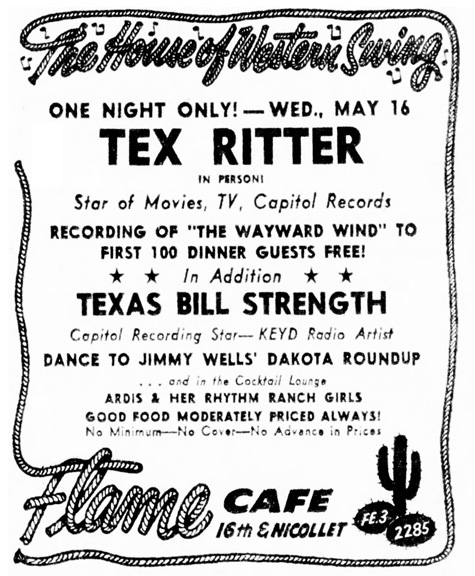
Minneapolis Tribune, May 1956
TEXAS BILL STRENGTH
Before Texas Bill came to Minneapolis for his job as a disc jockey in 1955, he had been all over the country, performing and recording. This included performances at the Grand Ole Opry, where he met many Country singers and groups. With these connections, he began to book the Flame with performers, who were attracted to the venue, but were also enticed by Bill’s descriptions of Minnesota’s hunting and fishing opportunities. Bill brought in many of the big names that came through the club, performed at the club, and also acted as master of ceremonies.
In an article in the (Nashville) Tennessean, it was reported that the country acts were booked by Lucky Moeller of the Jim Denny Artists Bureau. (February 12, 1961). In 1967, Raye Perkins told Billboard magazine that in 1956, he and Abe contracted with Lucky Moeller in Nashville to handle all the bookings for the club. This may have been true after Texas Bill disassociated himself with the club, a faulty memory, or antipathy towards Bill, but it is known that Texas Bill was personally responsible for bringing in many of the acts that established the Flame as a popular Country venue.
THE JUMPING COWBOY
Sharing the stage with Strength in September 1956 was Kenny Roberts, who appeared on September 12 through 15. Will Jones said that Roberts was a yodeler with several nationwide hit records.
His favorite trick, however, is leaping into the air, while playing guitar and harmonica at the same time, which gave him the nickname of “The Jumping Cowboy.”
Someone who knew him said he was a really nice guy.
1958
I couldn’t find a date or an ad for this show – Flame ads are notorious difficult to find, as they are literally written in a rope font, as well as many others! But here’s a photo of a Little Jimmie Dickens Show from 1958.
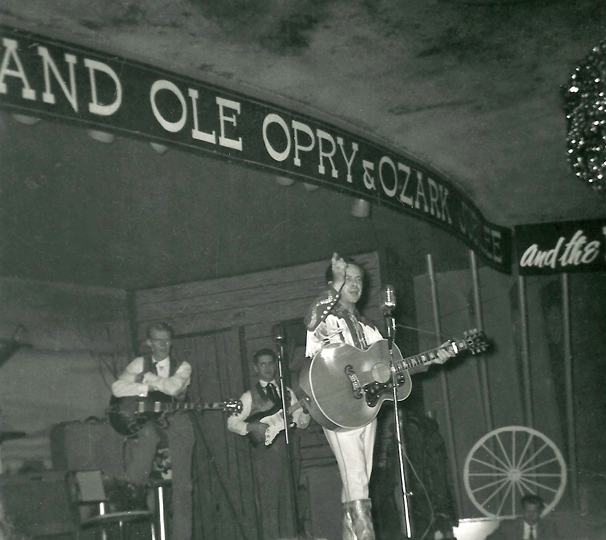
Photo Courtesy Gary Schwartz
1959
Carl Perkins appeared at the Flame on April 1 – 4, 1959, and Will Jones caught one of his performances: (Minneapolis Tribune April 6, 1959)
At the show I witnessed, Perkins wore a pink satin dinner jacket with lace lapels and cuffs, and a lace shirt. His black pants had a pink stripe. … The huge dining room was packed with country-western fans Saturday night [April 4], and there was a mob waiting beyond the ropes to get in.
Jones said this about the Flame’s strategy:
The flame uses a booking trick to keep the country-western customers stirred up: instead of bringing in a headliner for a week or two and milking his popularity, they book him for four days. The crowds come and a few get turned away. Then in about four months, they bring him back again and start the excitement all over.
1960
Below is a look at the rear of the building in April 1960. The circles indicate bullet holes!
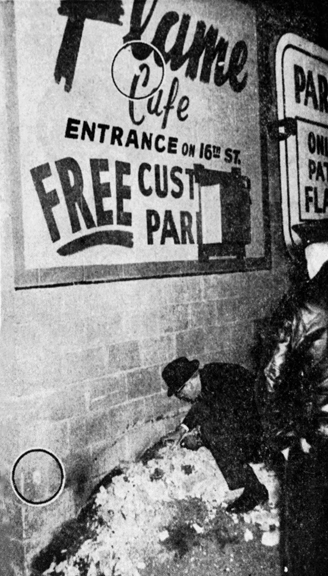
1961
KID CANN SAYS GOODBYE
By the way, if Kid Cann was still hanging around the Flame, that ended in 1961. He had been convicted of white slavery (bringing a woman across state lines for immoral purposes) in 1960, and got two years for that. In 1961 he was embroiled in a trial in which he was accused of Federal liquor violations. He was convicted and proceedings were underway to deport him back to Romania, but he got off on that. What he didn’t get off on was trying to bribe a juror, for which he got five years and a $12,500 fine. He was put in the Ramsey County Jail on March 30, 1961, which is where and when he started serving his 1960 sentence.
He got sent to Leavenworth for the first three years of his combined seven year sentence, and then to a medical center in Springfield, Missouri, because of a bad heart. In August 1964, his incredibly understanding wife, Lillian, paid his fine, and he was paroled after serving about serving about half his time on September 16, 1964. (Lillian’s address was given as 5900 Oakland Ave. in Minneapolis, where they had lived since 1952.) One of the conditions of his parole was that he was not allowed to return to Minneapolis to live. He settled in Miami, where he had amassed a lot of property. He died of heart disease on June 21, 1981, at Mt. Sinai Hospital in Minneapolis. He is buried at the Adath Yeshurun Cemetery at 56th and France Ave. in Edina (Row 1, Section 3).
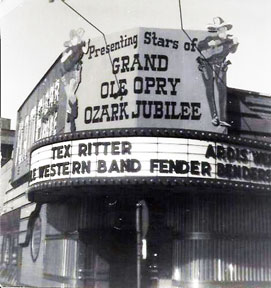
April 1961 Photo by Sherwin Linton
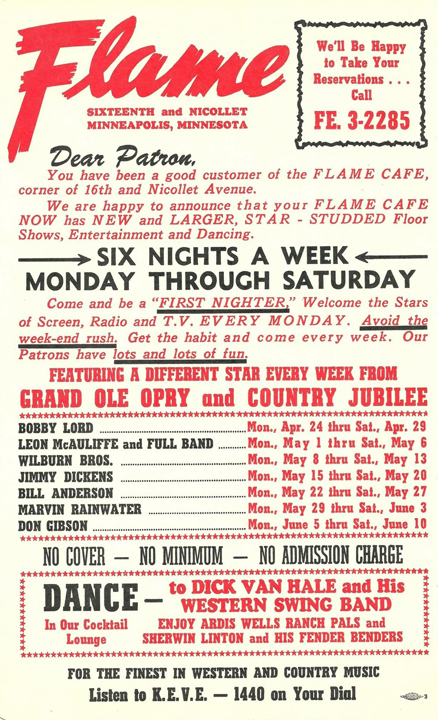
1961
FLAME RECORDS
Somehow in 1961, the Flame got into the record business! But as far as anyone knows, including the family, there were only two 45s issued. The first, put out in 1961, was by an appropriately-named chanteuse named Diane Flame, with accompaniment by Little Leon Ulrich and “Be Bop” Feathers. Diane’s musical offerings were:
- Cold Cold Heart, the Hank Williams standard, and
- My Shoes Keep Walking Back to You
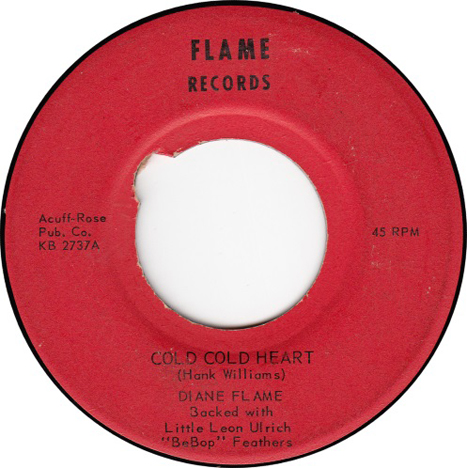
Image courtesy 45Cat.com
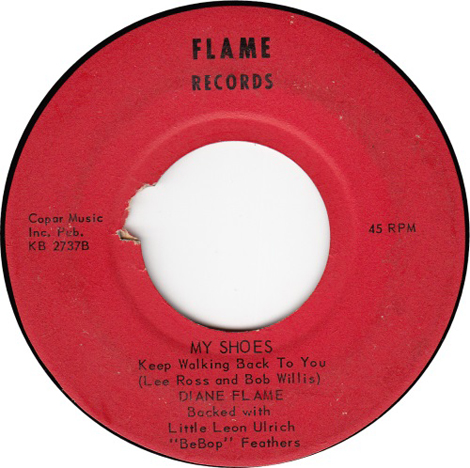
Image courtesy 45Cat.com
Jump forward to 1972 or 1973, and another 45 emerges from Flame Records. This one is put out by one Mary Beth – it’s almost as if these women wanted to remain anonymous! Mary Beth’s two songs were:
- Your Sweet Love, and
- You Should Live My Life, produced by none other than Abe Perkins himself!
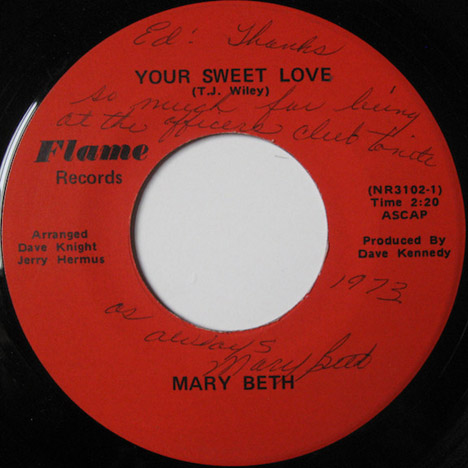
Autographed copy from Discogs.com
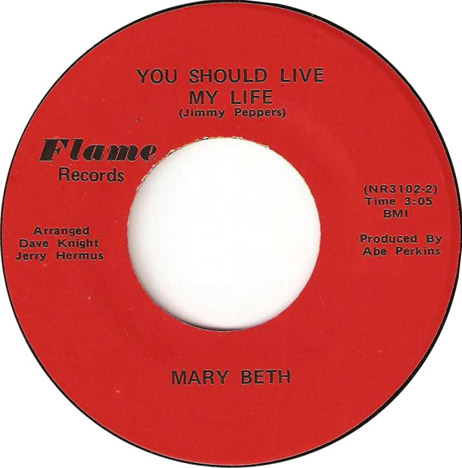
Image from 45Cat.com
If anyone knows any background on Flame Records, please Contact Me! Thanks! And thanks to record collector Derik Olson and Abe’s grandson Marc Percansky for assistance with this mystery!
1962
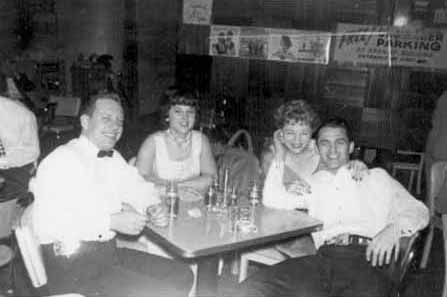
Jimmy Jensen, ?, Fern Dale, Benny Heilman in the Lounge, late 1961/January 1962. Photo courtesy Brett Williams
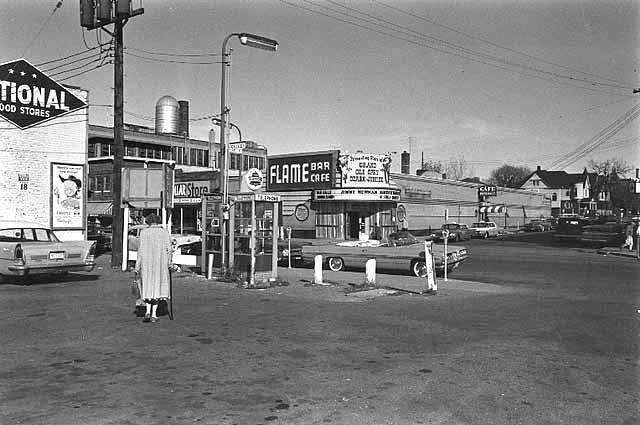
1962 Photo courtesy Minnesota Historical Society
1963
An obituary for Harry W. Beell identifies him as manager of the Flame Cafe for ten years. He was the brother-in-law of Ray Perkins.
The stories about the Flame are many and often hilarious. The following remarks are from Sherwin Linton, from an interview in Metro magazine:
Webb Pierce drove a Pontiac Bonneville with silver dollars attached to it and parked it on Nicollet Ave. with the top down while he played his shows. People would stop and look at it but didn’t bother it.
It was a nationally-known place; every week Billboard and Variety magazines would write about what was happening at the Flame. National talent agents would come in there and national critics as well. Sports personalities and other people would hang out together. They had this $2.50 T-bone steak dinner, which was at that time a very good price. Most places would charge five bucks for a steak at that time. It was a kind of place where the middle class – and even somewhat rednecks, so to speak – could hang out. But professional people and the affluent also went there to let their hair hang down. The other people went there to put on the dog. They all co-mingled with no problem at all.
1964
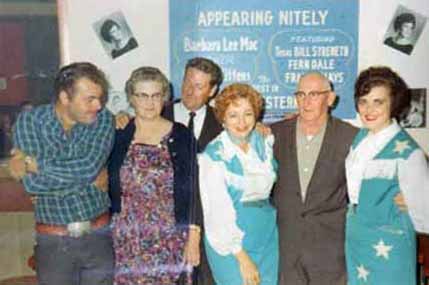
Fern Dale and Barbara Lee Mac posing with fans, @ August 1964
HOOTENANNY JAMBOREE
Here’s an item of no importance, but Will Jones devoted his entire column to it in the Tribune on September 14, 1964, so let’s give it a go.
Seems there was this chap from North Carolina named Riley Cooper who had this idea to put together a daily Country radio show on 18 Minnesota stations. It would be called “Hootenanny Jamboree,” and emanate from the Flame from 1 to 3 pm. Each show would feature whichever name performer was at the Flame that day, with 20 musicians for each show. Cooper, described as a “country-western performer, songwriter and publisher, would function as producer, master of ceremonies and resident star.” KTCR would be the Twin Cities outlet for the show. There would be a new sponsor ever 15 minutes.
Well, other than this initial article, nothing comes up in a search for “Hootenanny Jamboree,” and the only Riley Cooper in town was a basketball player. Oh well. Best laid plans.
1966
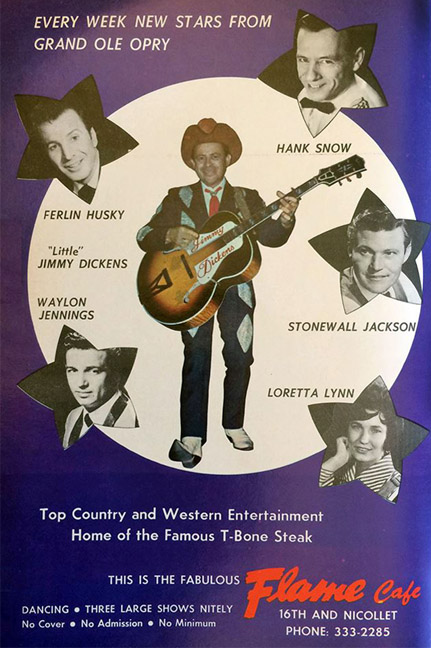
Poster from 1966 – or 1969?
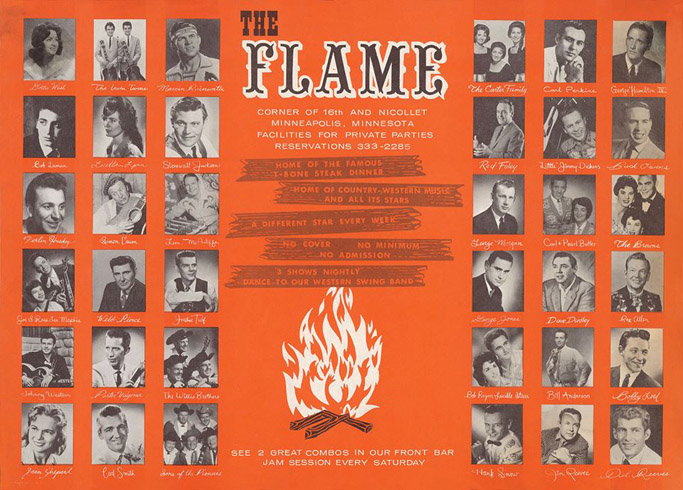
1969
In 1969, Will Jones reported a rumor that the Flame would move from Country to hard rock in its Main Room, but said that even though the move had been considered, the plan had been abandoned. The problem wasn’t that Country music was waning in popularity – on the contrary, it was bigger than ever, with “Hee Haw” and the “Johnny Cash Show” hitting the airwaves. This led to the stars pricing themselves out of the Flame’s budget, and week-long engagements were no longer feasible. Owner Abe Perkins speculated that he would only be able to bring in big names twice a month, and then only on weekends. And with those shows, he may have to add a cover charge, which patrons in Minneapolis were not used to. (Minneapolis Tribune, June 19, 1969)
High talent costs still vexed the Flame, as Country music got more and more popular and acts that used to work for $600 to $800 a week now demanded $5,000 a night. Others doubled their rate, according to Will Jones in February 1970. In response, the Flame went to a local-band only policy. Then they briefly tried bring back big names for split weeks, but the entertainers wanted more for three nights than they used to get for six, so the local band only policy was resumed. (Minneapolis Tribune, February 8, 1970)
High talent costs were not the only problem at the Flame. Abe remembered in 1977:
“People are not as orderly as they used to be. Up until 1968, I used to work this place alone with two women hostesses.” Now Abe needs three bouncers to work the floor after 6 pm. They often used to be off-duty cops, but the police department has declared the Flame off-limits because too much “rough stuff” goes on. A Flame bartender was shot and killed there [in 1975]. (Minneapolis Star, May 12, 1977)
1970
Will Jones reported that in order to get around the high cost of talent, the plan was put in place to bring in big name acts only every other week. (Minneapolis Tribune, February 8, 1970)
1972
HAWAIIAN FEMALE IMPERSONATORS?
On June 26, 1972, Will Jones reported that starting that week, the Flame was going out of the country-western business. There were too many Country bars, and the best-known entertainers had priced themselves out of the market.
So Abe and Ray Perkins went to San Francisco, looking for a new direction. The result was a production called “Hawaii Today,” sub-billed as “The Third Sex.” Some of this is repetitive of the description below, but is too funny to be believed:
There’s a chorus line of six fellows, the Pearls of the Pacific, who do girlie-show numbers in Hawaiian, Samoan, Tahitian, New Zealand, and Japanese styles.
Headliner of the show is an entertainer billed as Prince Hanalei, whose gender the Perkinses hesitate to label. The Prince’s specialty act includes walking on fire and then standing on his head with burning tassels attached to his buttocks, twirling the tassels through manipulation of his gluteal muscles. There’s a stripper billed as Sabrina.
In July 1972, Will Jones reported that the Flame had converted its Main showroom into “Paradise Isle,”
with bamboo on the walls and a setting of fake volcanic rock and tropical greenery on the stage. Six of the most stunning showgirls you ever saw slink and prance through Polynesian flavored production numbers, and if they’re not really girls but guys who like to dress that way (the only giveaway is their big feet). Well, that’s showbiz. They’re beautiful.
And the country touch isn’t that far away, either. The Chill Hilmin band still plays in the front bar. And when, in the backroom, The Hawaiian Expression gets going on a New Zealand number to back up the dancing, the yipping and the yahooing from the band are like echoes from the past.
After having printed some advance word on Prince Hanalei, the headliner, who walks on fire and then stands on his head and twirls flaming tassels attached to his bare buttocks, there isn’t much more to say. Except that, now that I’ve seen it, I can add that, yeah, he sure does all that stuff. And with style.
Another headliner is Macey Williams, who functions as comic, singer and emcee. He makes a very funny business out of singing “My Way” as he puts on his full drag costume, piece by piece, in full view of the audience. There is also something hilariously inappropriate about his appearance in a geisha costume to sing “On the Street Where You Live.”
It’s a lively, flashy, well-staged production that goes on for about 90 minutes, with excellent backing by The Hawaiian Expression. If there’s such a thing as Polynesian rock, that’s what they play. (Minneapolis Tribune, July 6, 1972)
This new feature started on June 29, 1972.
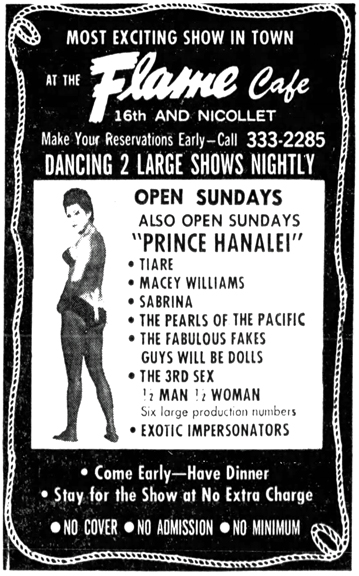
Minneapolis Tribune, July 2, 1972
1973
March 10, 1973: After discontinuing its country format a year ago, the Flame reverted to form and began bringing in big name country performers again. There are now two full-time country house bands: Texas Bill Strength and his group in the front lounge and the Chill Hilmin Country Show in the Main room. Part of the renewed interest can be attributed to the addition of an all-night country show on KTCR-FM with Gregg Elsworth. KSTP AM also has a midnight to 6am country show directed specifically at truck drivers and other night people, hosted by Al Carlson. (Will Jones)
R&B AND COUNTRY
The all-country format apparently didn’t work out, and drastic changes were made. It’s been a little difficult to pin down what went on in the ’70s, but I’ll put down what I have. Thanks very much to my Facebook Friends and musicians for their help!
COUNTRY IN THE FRONT
As far as I can tell, there continued to be Country bands in the Front Bar, perhaps until the very end in September 1978. There was a sighting of Little Jimmie Dickens’ motorhome on his way to a gig in 1978, so that may be a clue.
GETTING ALONG
There was a hallway from the front Country bar to the back Main room. Mixing Country and R&B seems like a recipe for disaster, but it seemed to work. Bobby Vandell, drummer for the funk band Our Father’s Children, explains:
As you can imagine, the patrons were mixed to say the least, and they shared the same bathrooms with very few incidents. I always felt comfortable there – of course all the Brothers and Sisters dug me cause I was the funky drummer. It didn’t hurt having an afro bigger than anyone.
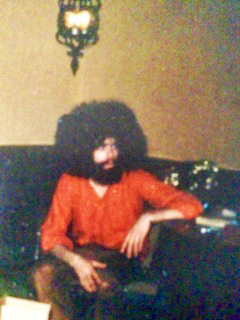
Bobby Vandell’s ‘Fro
THE ZODIAC ROOM
The Main Room became the Zodiac Room, the home of Rhythm and Blues. The local bands who appeared in the Zodiac room included:
- Band of Thieves
- Flight Tyme (precursor to the Time)
- Willie and the Bees
- Scorpion (“kind of a velour funk band,” says member Hearn Gadbois)
- Haze (perhaps)
- The Lake Street Stink Band, a blues band Gary Schwartz was in, played the main room in the mid-’70s.
- Our Father’s Children, with Bobby Vandell
THE PHILADELPHIA STORY
Perhaps the biggest local name was the Philadelphia Story. The group started as the Val-Dons, while the members were in the Navy in Pensacola, Florida, in 1968. When they were discharged, they eventually regrouped in Minnesota, Where they changed their name to the Philadelphia Story.
They were a singing group, and would hire a separate instrumental group to back them. According to Robb Henry, who worked for them for the summer of 1975 in the Storefront Band, the Philadelphia Story was very professional, giving out paychecks, taking out taxes, and expecting regular rehearsals.
Below is the Philadelphia Story: Monroe Wright III – William H Clark – Maurice W Young – Clifton Curtis Jr.
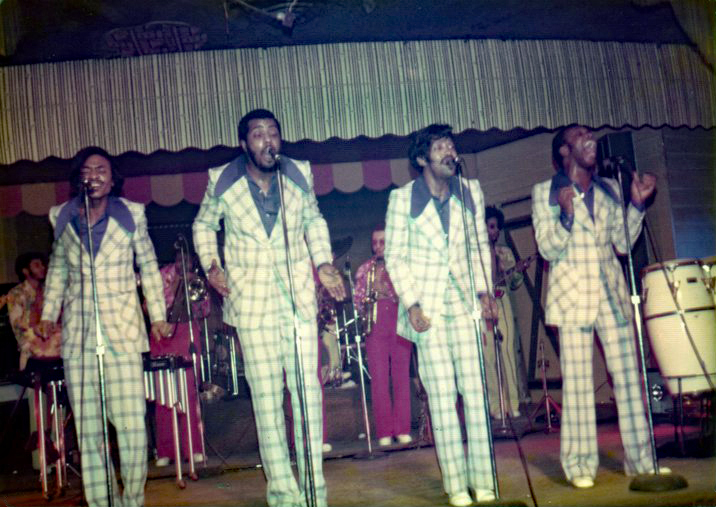
Photo courtesy Monroe Wright III
1974
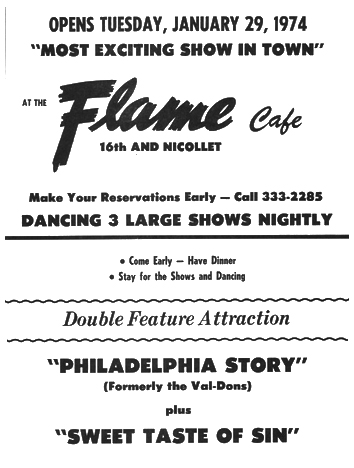
January 1974. Ad courtesy Monroe Wright III
Another regular band that backed up the Philadelphia Story was the Sweet Taste of Sin. At some point the two units merged into Sweet Story.
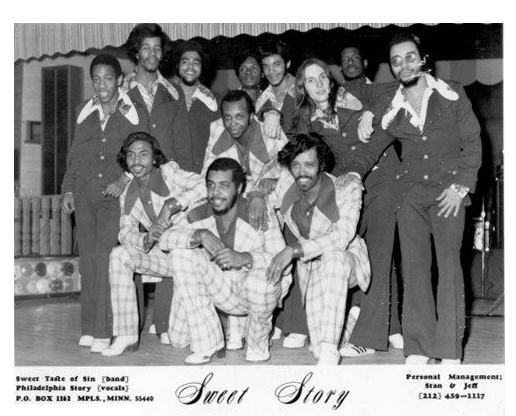
Photo courtesy Monroe Wright III
Sweet Story played the Zodiac room several times circa 1974/1975.
1975
DAVID RUFFIN
Seth Schwartz of the Minnesota Daily reported that the Flame was starting a six month trial period of bringing in nationally-known black performers. The first of these was David Ruffin, former lead singer of the Temptations. Ruffin performed in the Zodiac Room July 1 through 6, 1975. The show was opened by local vocalists the Philadelphia Story, and musicians the Storefront Band, featuring our own Robb Henry, who got a great review. Schwartz was not impressed with Ruffin’s own band, the Ruff-Riders. KUXL Disc Jockey Pharoah Black was the Emcee of the show. (July 11, 1975)
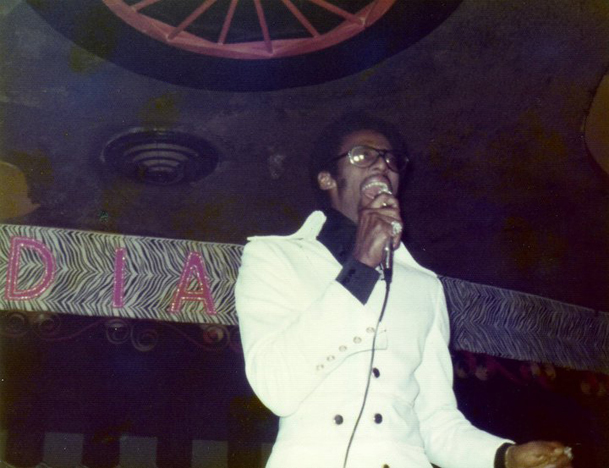
Photo of David Ruffin courtesy Monroe Wright III
EDWIN STARR
Another National Act was Edwin Starr. Starr’s biggest hits on the U.S. Pop and R&B charts were:
- Twenty-Five Miles (#6 on both charts) 1969
- War/Stop the War Now (#1 Pop, #3 R&B) 1970
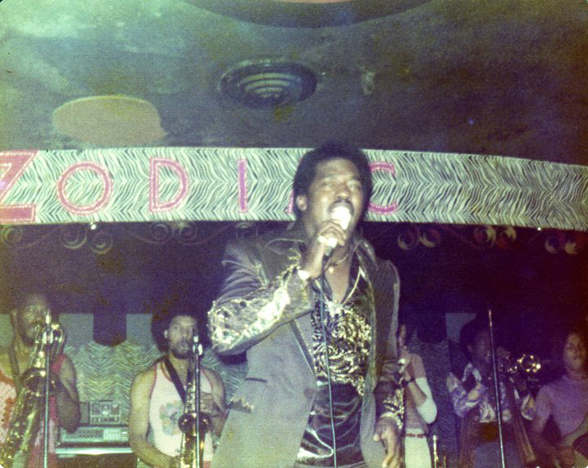
Photo of Edwin Starr courtesy Monroe Wright III
The Sweet Taste of Sin was at the Flame in October 1975.
On December 8, 1975, a bartender was shot two times at about 9 pm and died at HCMC on December 9, 1975. (Minneapolis Tribune, December 10, 1975)
1977
The Main room was described as a disco in a Minneapolis Star article.
Spotted in the TV listings: A show on Channel 2 called Wyld Ryce called New Year’s Musical Pilaf on December 30, 1977, with:
- The Reginald Buckner Quartet
- Danny L. and the Brewerettes
- The Chill Hilmin Country Show, featuring Kim Martin
- Hosted by Pharaoh Black, DJ at KUXL
This just HAS to have been taped at the Flame, don’t you think?
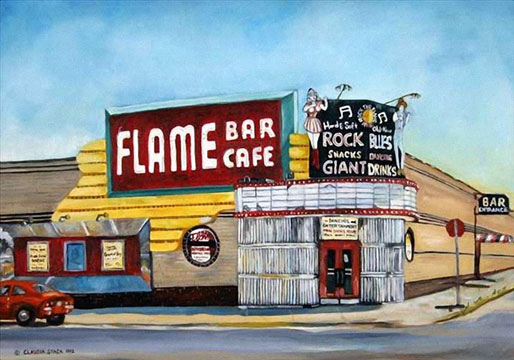
Painting by Claudia Stack
1978
THE FLAME GOES OUT
During the first six months of 1978, 25 people were arrested at the Flame for prostitution.
In June 1978, police arrested the “King of the Pimps,” who called himself Cassanova, at the Flame. He allegedly had pimps working for him. Kind of a Pyramid Scheme for pimps.
In July 1978, a City Council committee recommended that the club’s liquor license be revoked for prostitution. While filming a story at the bar about the decision on July 1, WCCO-TV cameraman Robert Cowan was attacked, and reporter Karen Boros had a gun pointed at her when she tried to go for help. The attacker’s motive was that he didn’t want his picture taken, but it the whole incident was filmed, and he was caught in the act.
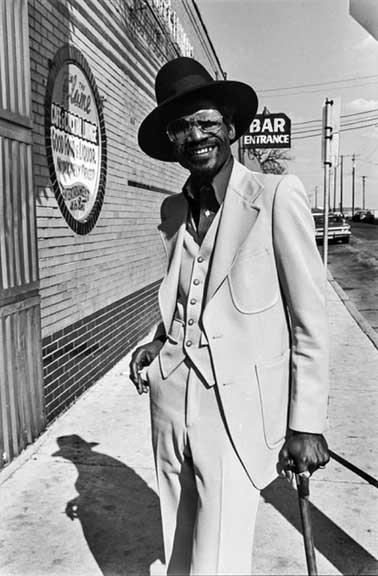
Man by the Flame, 1978. Photo courtesy Minnesota Historical Society
Under the gun from police for being a haven for prostitutes and the site of assaults, the Minneapolis City Council revoked the club’s liquor license on September 7, 1978. The decision came after two teenage prostitutes testified that they often worked out of the Flame. Abe had requested a temporary restraining order barring the City from closing the club, but the court denied it. Papers were served at 6 pm that fateful Thursday, and six minutes later, the Flame was snuffed out. Customers refused to believe it or leave until they got the word from Abe or his son Mort, and saw the news on the bar’s TV. (Minneapolis Tribune and Minneapolis Star, September 8, 1978)
At the time of closing, the sign promised Hard & Soft Rock, Old & New Blues, Snacks, Dancing, and Giant Drinks. The Marquee simply said Disco Soul.
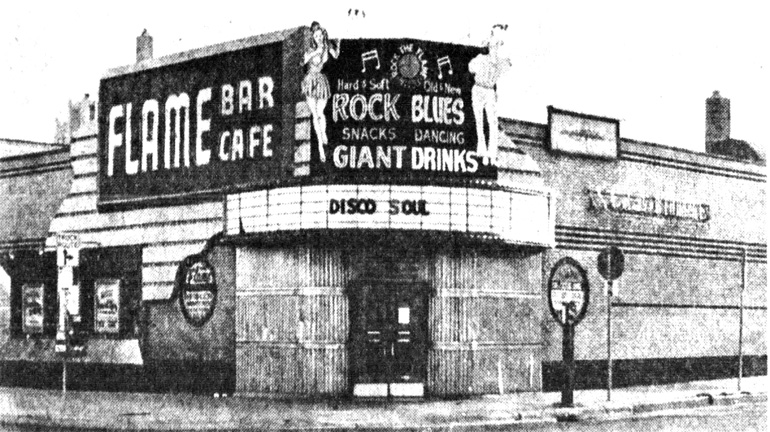
The Flame in 1978. Minneapolis Star, July 25, 1980
1979
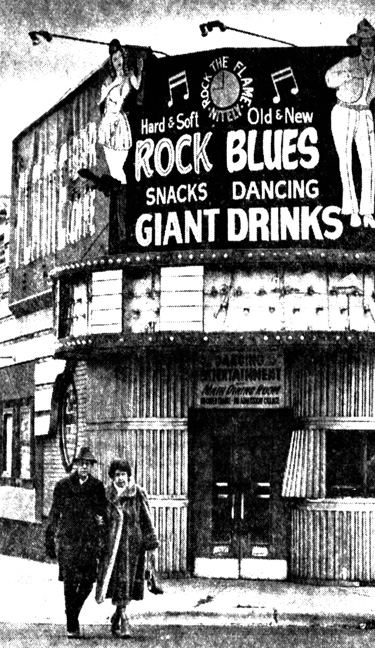
Flame Marquee in shambles. Minneapolis Star, December 3, 1979
1980
At age 76, Abe still hoped to regain his liquor license, but he filed his appeal one day too late. The Hennepin County District Court was sympathetic, but in July 1980, the Minnesota Supreme Court held that the City’s revocation would stand.
Abe died on January 23, 1985, and is buried at the United Hebrew Brotherhod Cemetery in Richfield.
1981
GREATAPES
In 1981 the building became the home of Greatapes Multimedia Company, owned by Jim and Diane Woelm. The new owners were respectful of the building’s history, and displayed photos of performers who have appeared at the old Flame that came with the building. Greatapes has now rented out the old Flame and moved around the corner.
GONE BUT NOT FORGOT
On October 15, 1995, Sherwin Linton organized a Flame Cafe Day at the Bel-Rae Ballroom, starring Hank Thompson. Sherwin and his band the Cotton Kings also performed, as did numerous local Country stars who had played at the Flame.
Jim Meyer reported in the City Pages on October 11, 1995 on some of the special guests:
- Fern Dale, the tenor banjoist who led a dazzling all-woman group in the ’60s
- Bobby and Cal Houle of the Houle Brothers
- Johnny Fields of KFAI’s Good ‘n’ Country, and a free-lance steel player known as “the mad scientist” in the old days.
- Cable-TV country VJs Viva and Jerry, who wer frequent patrons
- Larry LaPole of the Polecats
